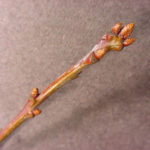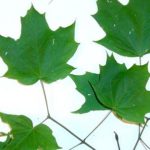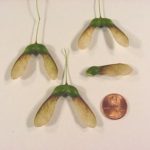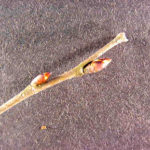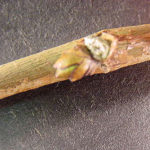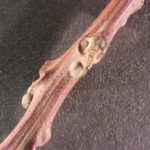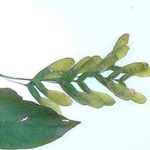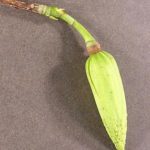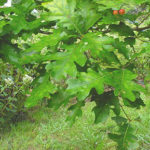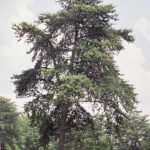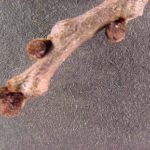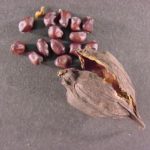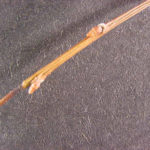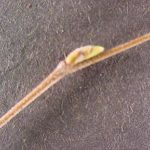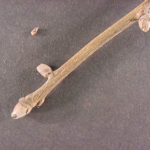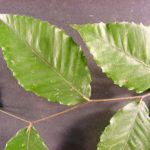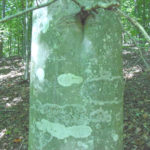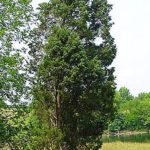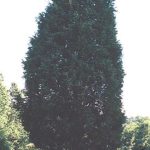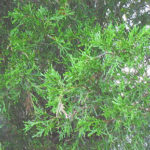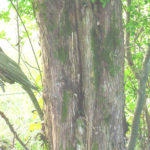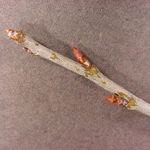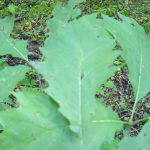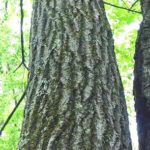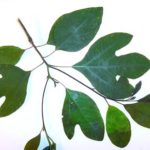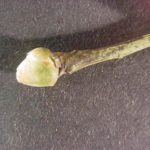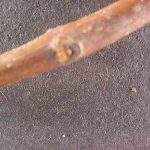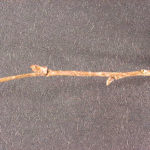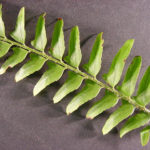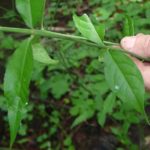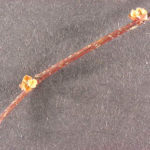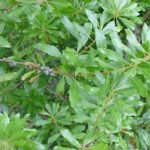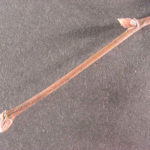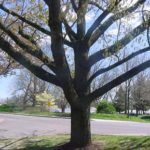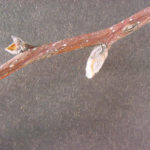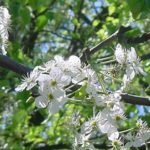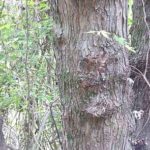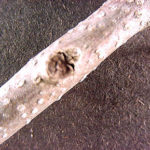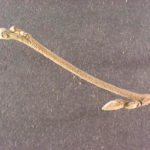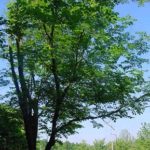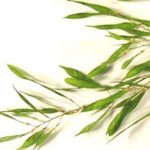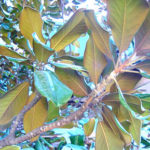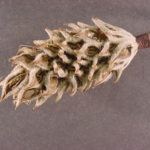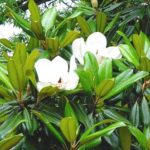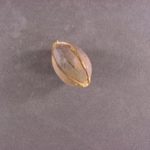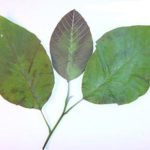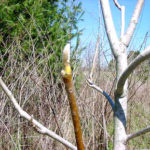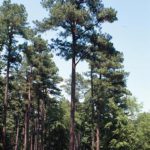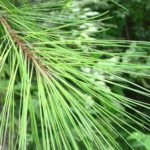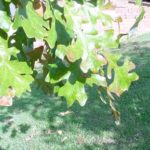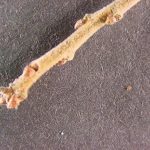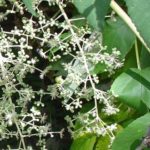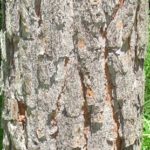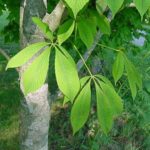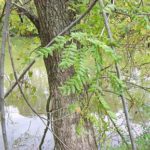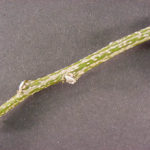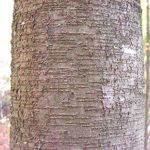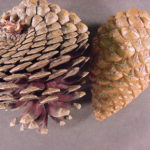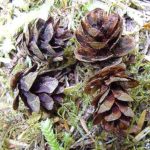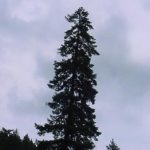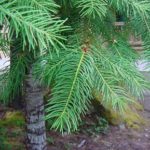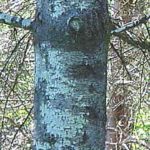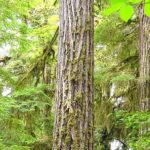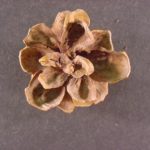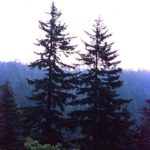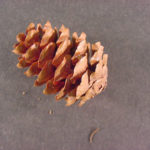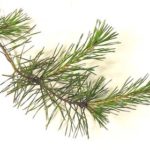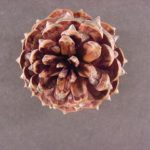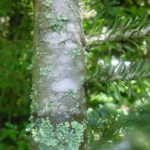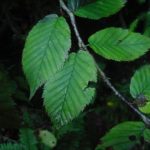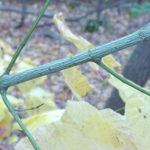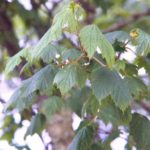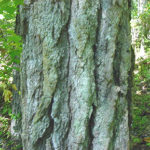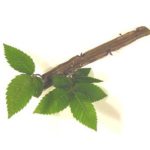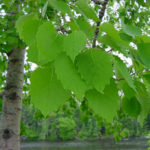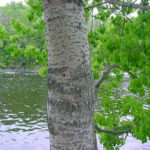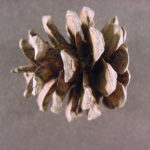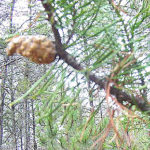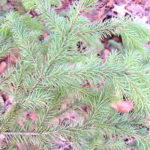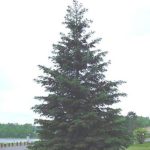Select a Common or Scientific Name below:
or create your own search:
baldcypress (Taxodium distichum var. distichum)
Family: Cupressaceae
Categories |
Images |
|---|---|
| Form:
A large tree with a triangular shaped crown and a tapered base, often with knees that protrude from the forest floor or water around the base of the tree. |
|
| Needles: Arrangement: 2 ranked Length: 1/4 – 1/5 inches Shape: acicular |
|
| Bark:
Dark red-brown to gray with shallow furrows, fibrous as well. |
|
| Cones:
Monoecious. Cones are found in clusters of 2 or 3, maturing in December. |
|
| Distinguishing Characteristics:
Usually found only in wet areas, with characteristic knees protruding from the ground or water around the base of the tree.The leaves are feathery like and deciduous. Trunk is usually buttressed at the base. |
|
| Range:
Grows along the Atlantic Coastal Plain from southern Delaware to southern Florida, west to southeastern Texas. |
|
| Silvics:
Intolerant. Grows best on drier sites but cannot compete with the faster growing hardwoods. As a result it is restricted to wet soils containing clay, or fine sand where moisture is abundant and fairly permanent. |
|
| Ecological and Cultural Importance:
Wood is extremely resistant to decay and is used in building construction, fence posts, doors, blinds, and flooring. Seeds are browsed by wild turkey, wood ducks and squirrels. The seed is a small part of the diet for waterfowl and wading birds. Area under and around tree provides watering places for a multitude of birds, mammals, and reptiles of the surrounding wetlands. |
chestnut oak (Quercus montana)
Family: Fagaceae
Categories |
Images |
|---|---|
| Form:
It reaches 65 to 80 ft. tall and 2 to 3 ft.in width. On good sites it can reach a maximum size of 100 ft. in height and 6 ft.in width. It generally has a straight trunk and narrow crown. |
|
|
Leaves: Shape: obovate-elliptical Margin: crenate Texture: glabrous above, and often finely pubescent below Variation: pinnate |
|
| Bark:
Nearly black to a brownish gray, mature trees have very deep and coarse furrows with ridges forming blunt v’s in cross section. |
|
| Twigs and Buds:
Twigs are reddish brown to orange. Terminal buds are long and usually acute with brownish-orange scales. |
|
| Flowers and Fruit:
Male flowers are green. Female flowers are reddish brown. They occur as single spikes. Paired or solitary, long ovid shape, lustrous. Acorns about 1 in. long topped with a thin, tight cap with oppressed scales. |
|
| Distinguishing Characteristics:
Look for the crenate margin (very large serrations) on leaves, brown-orange color to twigs and buds. |
|
| Range:
Occurs primarily in the Appalachian Mountains and in adjacent areas with similar topography. Distributed from southwestern Maine to extreme southeastern Michigan south to extreme northeastern Mississippi. Rare on the Southeastern Coastal Plain, but occurs along the coast in Delaware, New Jersey, New York, and in the New England states. |
|
| Silvics:
Intermediate tolerance. Upland species, commonly occurring on ridge tops and upper slopes. Found on dry, rocky, infertile soil with a low moisture-holding capacity. Grows best in rich, well-drained soils along streams. |
|
| Ecological and Cultural Importance:
The wood is cut and utilized as white oak lumber. When available, due to infrequent large crops of acorns, the acorns are eaten by numerous upland wildlife species, including white-tailed deer, squirrels, chipmunks, mice, and wild turkeys. White-tailed deer occasionally browse young sprouts. Small birds, mammals, and insects such as bees, use cavities for nesting. |
sugar maple (Acer saccharum)
Family: Aceraceae
Categories |
Images |
|---|---|
| Form:
In the open, forms a large, dense and rounded crown. In forest conditions, the bole is clear straight and full. |
|
|
Leaves: Shape: 5 lobes with u-shaped sinuses Margin: entire Texture: N/A Variation: palmate |
|
| Bark:
Light gray to grayish-brown, becoming rough, peeling from the top and bottom of each piece that is being shed when older. |
|
| Twigs and Buds:
Shiny reddish-brown to brown with light colored lenticels. Terminal buds are long and sharply pointed. |
|
| Flowers and Fruit:
Flowers are bright yellow and long pedicelled. The fruit is a samara. |
|
| Distinguishing Characteristics:
5 lobed leaves, with a definite u-shape sinus, palmately shaped leaves, gray bark with deep furrows (on older trees). |
|
| Range:
Grows from Nova Scotia west to Minnesota, south to northeastern Texas and extending eastward into Georgia. |
|
| Silvics:
Tolerant. Occurs in rich, mesic woods but can also grow in drier uplands. It grows in coves and other sheltered areas. Often associated with stream banks, valleys, canyons, and wooded natural levees. |
|
| Ecological and Cultural Importance:
Commonly used to make furniture, paneling, flooring, and veneer. It is also used for bowling pins, and musical instruments. It is browsed by white-tailed deer, moose, and snowshoe hare. Red squirrel, gray squirrel, and flying squirrels feed on the seeds, buds, twigs, and leaves, porcupines have been know to consume the bark. |
slippery elm (Ulmus rubra)
Family: Ulmaceae
Categories |
Images |
|---|---|
| Form:
Medium sized, 60 – 70 ft. in height, 18 – 30 in. in dbh. |
|
|
Leaves: Shape: elliptical to obovate Margin: doubly serrate Texture: scabrous above, pubescent below Variation: parallel |
|
| Bark:
Red brown bark, non-diamond shaped fissures, does not show patches or streaks when sectioned. Mucilaginous inner bark. |
|
| Twigs and Buds:
Ash to brown gray in color, scabrous, buds pubescent. Buds are chestnut brown to black in color. |
|
| Flowers and Fruit:
Flowers appear in short pedicelled fascicles. |
|
| Distinguishing Characteristics:
Doubly serrated leaf, scabrous leaf and twig, bud more stout that American Elm buds. |
|
| Range:
Southern Maine west to Nebraska, south to Louisiana. |
|
| Silvics:
Intermediate tolerance. Rich, moist bottomlands, along streams. |
|
| Ecological and Cultural Importance:
Not important for lumber, used in manufacture of boxes, baskets and crates. Seeds are eaten by birds and small mammals, twigs are browsed by deer and rabbits. |
blue ash (Fraxinus quadrangulata)
Family: Oleaceae
Categories |
Images |
|---|---|
| Form:
This is a medium sized tree with a height to 80 feet tall and a width of 2 ft. It has a short bole and an irregular crown. |
|
|
Leaves: Shape: lanceolate Margin: serrated Texture: glabrous Variation: pinnate |
|
| Bark:
Blue ash bark is brown to ash gray, and rough and scaly when young. When the tree matures it forms irregular fissures and scaly ridges giving a shaggy appearance. |
|
| Twigs and Buds:
It has a relatively stout twig that is 4-angled. The leaf scars are notched and the buds are gray to reddish brown in color. |
|
| Flowers and Fruit:
The flowers occur in panicles that appear before the leaves. The fruit is a samara, with a wide wing and a flattened seed. |
|
| Distinguishing Characteristics:
It has opposite compound leaves and the twigs have 4 distinct edges. The inner bark turns blue when exposed to air. |
|
| Range:
Blue ash is found in Southern Wisconsin west to Ohio, south to northern Georgia and west to eastern Oklahoma. |
|
| Silvics:
This species in most common on calciferous dry limestone uplands. |
|
| Ecological and Cultural Importance:
It was once used for blue dye by the pioneers. The wood is used in flooring, baseball bats, furniture, tool handles, barrels and crates. |
American elm (Ulmus americana)
Family: Ulmaceae
Categories |
Images |
|---|---|
| Form:
Height ranges from 40 ft. to 125 ft. and the diameter ranges from 48 in. to 60 in. This tree usually forks near the root collar and rises to have a small arched branch crown. |
|
|
Leaves: Shape: varies from oblong obovate to elliptical Margin: doubly serrate Texture: top is glabrous and occasionally slightly scabrous, bottom is pubescent Variation: parallel |
|
| Bark:
On mature trees it is separated into grayish, flat ridges. The outer bark, when pulled from tree, is layered with reddish brown fibrous tissue. |
|
| Twigs and Buds:
The twig is slender, brown, and glabrous with occasional slight pubescence. Lateral buds are oval shaped, coming to a point at the apex, but not sharply. Buds have a light reddish brown color. |
|
| Flowers and Fruit:
Flowers appear before the buds opens and occur in fascicles of 3 and 4. Fruit matures in the spring and is oblong obovate with a ciliate margin. |
|
| Distinguishing Characteristics:
Sectioned bark is layered with reddish brown fibrous tissue in the middle. |
|
| Range:
American elm is found in Nova Scotia west to eastern Montana, and south to central Texas. |
|
| Silvics:
It is commonly found on flats and bottom lands and does not appear at elevations above 2,500 ft. It grows best on well drained rich soils. The species is deemed to have soil improving characteristics because of its nutrient rich rapidly decomposing leaf litter. |
|
| Ecological and Cultural Importance:
Fruits and saplings are browsed by wildlife, especially deer and rabbits. It was formerly used extensively in landscaping, but has lost it’s popularity due to it’s susceptibility to Dutch elm disease. This species is the state tree of Massachusetts and North Dakota. |
wild hydrangea (Hydrangea arborescens)
Family: Hydrangeaceae
Categories |
Images |
|---|---|
| Form:
Shrub that can reach up to 8 ft. in height and having an open and rounded crown. |
|
|
Leaves: Shape: ovate Margin: coarsely serrate Texture: tomentose below Variation: pinnate |
|
| Bark:
Light brown and exfoliating. |
|
| Twigs and Buds:
glabrous, light brown to brown, leaf scar shallow |
|
| Flowers and Fruit:
Small white flowers in flat topped or rounded clusters. Fruit is a ribbed brown capsules |
|
| Distinguishing Characteristics:
shrub, white flowers, opposite arrangement, remains of fruit retained year round. |
|
| Range:
Eastern Half of the U.S. |
|
| Silvics:
Rich, damp soils of a deciduous forest. |
|
| Ecological and Cultural Importance:
Native Americans used to used the roots for a variety of medicinal applications. |
American hazel (Corylus americana)
Family: Betulaceae
Categories |
Images |
|---|---|
| Form:
A large shrub ranging from 3 to 10 feet in height. It has a straight trunk with spreading, rising branches. |
|
|
Leaves: Shape: oval with a cordate base Margin: doubly serrate Texture: pubescent below Variation: parallel |
|
| Bark:
It has smooth and light gray bark. |
|
| Twigs and Buds:
Twigs are slender with stiff red hairs and buds are somewhat flat topped. |
|
| Flowers and Fruit:
Monoecious with males flowers appearing as brown catkins and female flowers smaller, appearing as reddish threads coming from gray to brown buds. Brown nuts enclosed in a hairy, leafy husk with rough edges, mature in the late summer. |
|
| Distinguishing Characteristics:
Pubescent stems, doubly serrate leaves, with pubescent leaves and is a colonial species |
|
| Range:
Occurs from Maine to Saskatchewan, south to eastern Oklahoma, to Georgia, and north through New England |
|
| Silvics:
Tolerant. Occurs along streams, meadows, woodlands, roadsides. It grows best on rich, moist, well-drained soils |
|
| Ecological and Cultural Importance:
The leaves and nuts are browsed by birds, squirrels, and deer. The nuts were also used to flavor soups by the Native Americans. It has been used as an ornamental since the late 1700’s. |
bitternut hickory (Carya cordiformis)
Family: Juglandaceae
Categories |
Images |
|---|---|
| Form:
This is a medium-sized reaching a height of 60 to 80 ft. and 1 to 2 ft. in width. It has a rounded, open crown. |
|
|
Leaves: Shape: Lanceolate Margin: Serrate Texture: Glabrous above and Glabrous or pubescent below Variation: pinnate |
|
| Bark:
Bitternut has smooth bark when it is young. When is matures shallow furrows and narrow, small interlacing ridges develop. |
|
| Twigs and Buds:
The twigs are moderately stout, varying from a grayish-brown to greenish-brown color. Terminal buds are sulfur-yellow, pubescent, and valvate. |
|
| Flowers and Fruit:
The nut, which develops in September, is somewhat globose but flattened with a thin husk that has 4 distinct wings. The male flowers are catkins with 3 hanging from one stalk. Female flowers are short and 4-angled. Flowers appear from April to May. |
|
| Distinguishing Characteristics:
One of the best ways to identify this species is by looking for the sulfur-yellow terminal bud. Also make sure it is alternately arranged and has pinnately compound leaflets. |
|
| Range:
Bitternut is found in southern Quebec, west to northern Minnesota, south to eastern Texas, and northern Florida. It encompasses the eastern U.S. and is the only member of the pecan family in the north. |
|
| Silvics:
It occurs on a variety of sites including both dry uplands and moist woods and bottoms. It reaches it ‘s largest size in the rich bottomlands of the lower Ohio River Basin and is not found at the higher elevations in the Appalachian Mountains. Bitternut is the shortest lived of the hickories. |
|
| Ecological and Cultural Importance:
It is important for lumber and pulpwood. The fruit is not preferred by wildlife, but rabbits, beavers, and small rodents will sometimes feed on the bark. |
red mulberry (Morus rubra)
Family: Moraceae
Categories |
Images |
|---|---|
| Form:
Small tree with a spreading, rounded crown; height usually ranges from 15 to 70 ft. |
|
|
Leaves: Shape: orbicular Margin: coarsely serrate Texture: scabrous-pubescent above Variation: pinnate |
|
| Bark:
The bark is thin, reddish-brown to dark brown, and scaly developing irregular long ridges. |
|
| Twigs and Buds:
It has a relatively slender twig that zigzags and is often pubescent. Buds are covered with overlapping scales. |
|
| Flowers and Fruit:
Male and female flowers are small, green hanging catskins. Catkins appear in April and May. The fruit is similar to a blackberry and forms in clusters. Fruits mature from June to August. |
|
| Distinguishing Characteristics:
Two shapes of leaves, leaves coarsely serrated, fruit similar to blackberry. Sap is milky white. |
|
| Range:
Massachusetts west to southeastern Minnesota, south to central Texas and east to southern |
|
| Silvics:
Tolerant. Best growth occurs on moist, well-drained soils of coves and flood plains. It does grows on a variety of soils including clays, sands, and loams. It also tolerates a wide range of soil pH and is often found in pastures and on field borders. |
|
| Ecological and Cultural Importance:
It has little or no commercial value but has been used in the past for fence posts, furniture, interior finish, and caskets. Birds and small mammals eat the fruits. Notable species include wood ducks, bluebirds, indigo buntings, gray catbirds, eastern kingbirds, towhees, orchard orioles, brown thrashers, summer tanagers, vireos, red-cockaded woodpeckers, red-bellied woodpeckers, great crested flycatchers, Lewis’ woodpeckers, opossums, raccoons, fox squirrels, and gray squirrels. White-tail deer browse the the foliage and twigs and beavers have been know to consume the bark |
black walnut (Juglans nigra)
Family: Juglandaceae
Categories |
Images |
|---|---|
| Form:
This species can grow to a height of 125 ft, however, on average, it grows to around 80 ft. It has a long, smooth trunk and a small rounded crown. |
|
|
Leaves: Shape: ovate-lanceolate Margin: finely serrate Texture: glabrous Variation: N/A |
|
| Bark:
The bark is grayish black to a dark brown and separated into thin ridges by deep narrow furrows. |
|
| Twigs and Buds:
The twigs are stout with a light brown to an orange-brown color and have a light brown chambered pith. Large terminal buds are short, blunt, and covered with a few pubescent scales. Lateral buds are smaller. |
|
| Flowers and Fruit:
The flowers are staminate with 17 to 50 sessile stamens. The fruit is globose arranged solitarily on clusters. The husk is thick semi fleshy, yellowish green, pubescent, and with a strong odor. A hard ridged shell protects the nuts strong tasting meat. |
|
| Distinguishing Characteristics:
This species has 12 to 24 leaflets with the terminal leaflet missing occasionally. It also has stout twigs and branches with large leaf scars and a light brown chambered pith. |
|
| Range:
Occurs throughout the eastern U.S. south to northwestern Florida. Isolated populations are found in eastern Texas, western Oklahoma, central Kansas, and southeastern South Dakota. |
|
| Silvics:
This species grows best on deep, well-drained neutral soils that are moist and fertile. It grows slowly on wet bottomlands, dry ridges, and slopes and is commonly found on limestone soils. |
|
| Ecological and Cultural Importance:
It ranks with the most durable hardwoods in the U.S. The wood is heavy and strong. Used primarily for furniture, tables, and as an interior finish. The veneer is used in the highest grade plywood panels. The nuts are of great importance to the eastern fox squirrels diet. |
boxelder (Acer negundo)
Family: Aceraceae
Categories |
Images |
|---|---|
| Form:
This is a medium-sized tree generally 30 to 60 ft. in height and 2 ft. in width. It has an irregular bole, shallow root system, and a spreading crown. |
|
|
Leaves: Shape: Varies between ovate, oval obovate. or ovate-lanceolate Margin: Coarsely serrate or lobed Texture: Glabrous or slightly pubescent above, pubescent along the veins below Variation: N/A |
|
| Bark:
It has thin and light brown to gray bark with shallow interlacing ridges. Older trees are slightly furrowed. |
|
| Twigs and Buds:
Twigs are stout, green to purplish green. Leaf scars are narrow, connecting in raised points. Buds are white and hairy with the lateral buds appressed. |
|
| Flowers and Fruit:
Flowers are yellow-green drooping racemes, occurring in drooping racemes. Fruit occurs in the form of paired V-shaped samaras. |
|
| Distinguishing Characteristics:
It is opposite with compound leaves and green twigs. There is a square shape to it’s leaflets. It is in the maple genus |
|
| Range:
Box elder is found from Nova Scotia west to Southern Alberta and south all the way to Guatemala. |
|
| Silvics:
It grows best on moist sites along lakes, streams and flood plains, but it is also capable of existing in extreme climates and can withstand short periods of flooding. |
|
| Ecological and Cultural Importance:
There is very little commercial value in the wood, but it provides important shelter for many wildlife species. It serves as a pioneer species on moist sites helping to stabilize soils in disturbed areas. This tree could be poisonous to livestock. |
yellow poplar (Liriodendron tulipifera)
Family: Magnoliaceae
Categories |
Images |
|---|---|
| Form:
Very straight, few limbs, heights of 120 ft. and a dbh of 18 – 24 in. |
|
|
Leaves: Shape: 4 lobed, orbicular Margin: entire Texture: glabrous Variation: palmate |
|
| Bark:
on young trees dark greenish or orange-brown and smooth, with small white spots; soon ashy gray, breaking up into long, rough, interlacing rounded ridges separated by fissures; inner bark bitter and aromatic. |
|
| Twigs and Buds:
Twigs are moderately stout, reddish brown, bitter to the taste. Buds are long and flattened and have valvate scales on the the bud which give it a “duck bill” appearance. Stipule scars encircle the twig. |
|
| Flowers and Fruit:
The flower has and orange corolla with yellow-green petals. The fruit is similar to an okra pod, breaking up into samaras. |
|
| Distinguishing Characteristics:
One of the tallest and straightest trees in the forest. It is easily identified in the early spring by its light green pyramid shaped crown. Remains of seed pods on the limbs make it identifiable in the winter. |
|
| Range:
Central New York west to southern Michigan south Louisiana and east to Florida. |
|
| Silvics:
It is intolerant of shade and grows in coves and on moist slopes with deep rich soils. |
|
| Ecological and Cultural Importance:
Traditionally used for log houses; used by bears for dens |
green ash (Fraxinus pennsylvanica)
Family: Oleaceae
Categories |
Images |
|---|---|
| Form:
Small to medium sized tree reaching from 30 to 50 ft. in height and 20 in. in width. Irregular shaped crown with a poorly formed trunk. |
|
|
Leaves: Shape: Elliptic to lanceolate Margin: serrate Texture: Glabrous to silky above, pubescent below Variation: N/A |
|
| Bark:
Grayish brown with furrows progressing into narrow, irregular, interlacing ridges. |
|
| Twigs and Buds:
Varying from stout to moderately slender, gray to greenish brown in color. Terminal buds are conical to ovate with a rusty brown pubescence. Lateral buds are reniform to triangular in shape. |
|
| Flowers and Fruit:
Flowers before leaves appear. Male and female are both borne in glabrous to tomentose panicles. Samara as a fruit. |
|
| Distinguishing Characteristics:
Pinnately compound with 7-9 leaflets, serrate, samara as fruit, twig flattened at the nodes. Bud sits on top of the leaf scar. Usually found on moist sites. |
|
| Range:
Eastern U.S. to Canada and the northern Great Plains. |
|
| Silvics:
Intermediate tolerance. Moist bottomlands, stream side species. Once established can survive on dry sterile soils, adaptable to the extremes of climate. |
|
| Ecological and Cultural Importance:
High strength, hardness, high shock resistance, and excellent bending properties, allow it to be used in specialty items such as tool handles and baseball bats. Popular as a shade tree in residential areas due to its good form, adaptability to a wide range of sites. The seeds are browsed by a number of game and non-game animals. |
spicebush (Lindera benzoin)
Family: Lauraceae
Categories |
Images |
|---|---|
| Form:
Large rounded shrub often reaching 8 ft. or taller. |
|
|
Leaves: Shape: elliptical Margin: entire Texture: glabrous Variation: pinnate |
|
| Bark:
Grayish brown to brown with white lenticels. |
|
| Twigs and Buds:
It has gray to olive-green glabrous twigs. |
|
| Flowers and Fruit:
Flowers usually appear as small paired yellow balls, but may occur in clusters. Fruit is a shiny red drupe. |
|
| Distinguishing Characteristics:
When twig is cut or leaves are crushed a spicy, peppery smell is emitted. Alternately arranged. Red fruit is obvious in the fall |
|
| Range:
Eastern half of the United States |
|
| Silvics:
Shaded areas with moist to wet soils. Usually found on riverbanks and stream sides. |
|
| Ecological and Cultural Importance:
Several edible and medicinal uses; fruit eaten by wildlife. |
common persimmon (Diospyros virginiana)
Family: Ebenaceae
Categories |
Images |
|---|---|
| Form:
Small to medium sized tree 30 – 50 ft. in height and 1 ft dbh. Rounded crown with branches spreading at right angles. |
|
|
Leaves: Shape: ovate-oblong or oval Margin: entire Texture: glabrous Variation: parallel |
|
| Bark:
The bark is nearly black and broken into squarish blocks. |
|
| Twigs and Buds:
The bud is black and triangular. It has one bundle scar within the leaf scar. |
|
| Flowers and Fruit:
The plum-like fruit that is green when unripe and orange to black when ripe. |
|
| Distinguishing Characteristics:
Look for the black bud (remember- family = Ebenaceae, ebony = black). Also look for the plum-like fruit, alternate leaves, and the rough black bark. |
|
| Range:
Southern Connecticut south to Florida west to eastern Oklahoma. |
|
| Silvics:
It is shade intolerant and grows on both moist bottoms and dry uplands. |
|
| Ecological and Cultural Importance:
Wood used for veneer, golf club heads, and low grade lumber. Fruit is food for squirrel, quail, and opossum. |
smooth sumac (Rhus glabra)
Family: Anacardiaceae
Categories |
Images |
|---|---|
| Form:
This is a small tree reaching 5-20 ft. in height with spreading branches. |
|
|
Leaves: Shape: lanceolate Margin: serrate Texture: glabrous above and pubescent below |
|
| Bark:
The bark has a red-brown tint. It is smooth when young and slightly scaly with age. It is also lenticellate. |
|
| Twigs and Buds:
Twigs are glabrous and stout and have small rounded buds. |
|
| Flowers and Fruit:
It’s white flowers are dioecious. |
|
| Distinguishing Characteristics:
It has a reddish petiole reddish that contains a sticky sap. |
|
| Range:
It can be found throughout the eastern United States. |
|
| Silvics:
Smooth sumac is intolerant of shade. It is common on dry upland sites, along woods borders, and in small openings. |
|
| Ecological and Cultural Importance:
It is the most common of sumacs. The wood is not commercially valuable. |
Eastern hemlock (Tsuga canadensis)
Family: Pinaceae
Categories |
Images |
|---|---|
| Form:
Medium sized 60 – 70 ft. in height and 1-2 ft. in dbh Prymidal in shape. |
|
| Needles: Arrangement: paired; two ranked Length: 1/3-2/3″ long Shape: flattened needles with blunt tips Other: white stomata below |
|
| Bark:
scaly and thin when young, becoming deeply furrowed and ridged |
|
| Cones:
small cones (3/4″) |
|
| Distinguishing Characteristics:
shortest needles, small cones, terminal stem droops, 2 lines of white stomata below. |
|
| Range:
New England west to western Kentucky south in the Appalachian mountains. Grows from 1,000 to 5,000 ft. in elevation. |
|
| Silvics:
very tolerant; cool, moist soils along streams; mountain slopes, uplands |
|
| Ecological and Cultural Importance:
Mostly used for pulp. Provides a dense nesting habitat for birds. Seeds are food for birds and mammals. Important in moderating temperatures of stream habitats. |
Eastern cottonwood (Populus deltoides)
Family: Salicaceae
Categories |
Images |
|---|---|
| Form:
This is a medium-sized tree reaching 70-100 ft. in height and 2.5- 4 ft dbh. It generally has a thin, spreading crown and a straight bole. |
|
|
Leaves: Shape: deltoid with truncate base Margin: crenate-serrate Texture: glabrous Variation: pinnate |
Photo Courtesy: Robert H. Mohlenbrock, USDA NRCS Plants Database |
| Bark:
The bark is yellow-green and smooth when young becoming ashy gray, thick, and furrowed with age* |
|
| Twigs and Buds:
Terminal buds have a shiny brown appearance and are conical in shape. |
|
| Flowers and Fruit:
Silky-haired seeds develop with shells that drop in early spring; |
|
| Distinguishing Characteristics:
The petiole is long and flattened. The buds have a resinous strong scented odor. Look for a more acuminate leaf tip and serrations with more of a hook shape to distinguish this species from big-toothed aspen. |
|
| Range:
Eastern cottonwood is found north as far as New York, south into Florida, and west into Texas, but it is concentrated in the river bottoms of the eastern Great Plains. |
|
| Silvics:
This species is very intolerant and occurs alluvial bottoms. |
|
| Ecological and Cultural Importance:
This species is important for lumber, pulpwood and is slightly non-resistant to decay. Provide valuable habitat for deer and grouse in the Great Plains. |
white oak (Quercus alba)
Family: Fagaceae
Categories |
Images |
|---|---|
| Form:
Medium to large tree reaching 60 – 80 ft. in height and a dbh of 3 – 4 ft. with spreading branches. |
|
|
Leaves: Shape: 7-9 lobes, rounded; not bristle tipped Margin: entire Texture: glabrous above, glaucous below |
|
| Bark:
It has light ashy-gray colored bark that can be very thick. |
|
| Twigs and Buds:
Twigs are light reddish-brown in color, stout, and glabrous. Each twigs has multiple globose terminal buds. |
|
| Flowers and Fruit:
Acorns mature in one season. The warty cap covers about 1/3 of the acorn. |
|
| Distinguishing Characteristics:
It has 7 – 9 lobed leaves that do not come to a distinct point like most of the red oak species. It can be distinguished from the post oak by the different leaf shape. It does not have the cross-shape as does post oak. |
|
| Range:
Southwest Maine to Florida west to eastern Texas |
|
| Silvics:
It is intermediately tolerant of shade and occurs on mesic to dry upland soils. |
|
| Ecological and Cultural Importance:
Wood used in furniture, veneer, and paneling. Deer browse on twigs and leaves. Acorns eaten by a variety of animals. Most important consumers of acorns include: black bear, mallard, wild turkey, and ring neck pheasant. Also very long lived, up to 800 years. |
Virginia pine (Pinus virginiana)
Family: Pinaceae
Categories |
Images |
|---|---|
| Form:
It grows to 50 – 100 ft. in height and 2 – 3 ft. in dbh. An flat top and irregular bole with scraggly branches develop with age. |
|
| Needles: Arrangement: 2 per fascicle; twisted Length: 1-3″ long Shape: N/A Other: N/A |
|
| Bark:
It has thin, flaky, red-brown bark. |
|
| Cones:
The cone scales have purplish tinges (resembling a turkey tail) on outer edge with a small prickle at the end. |
|
| Distinguishing Characteristics:
Look for the turkey tail cone, 2 twisted needles per fascicle, and numerous dead branches. |
|
| Range:
Southern New Jersey west to southern Ohio south to northern Mississippi and east to Georgia. |
|
| Silvics:
It is very intolerant of shade and grows on dry uplands and droughty clay soils. |
|
| Ecological and Cultural Importance:
Used as pulpwood. Food source for small mammals, Northern bobwhite, and other birds. Can quickly reforest abandoned fields. |
Eastern white pine (Pinus strobus)
Family: Pinaceae
Categories |
Images |
|---|---|
| Form:
This is a large evergreen tree reaching 80 to 100 ft. in height and 2 to 4 ft. in dbh. Crowns often spread in width in open areas. This characteristic can be enhanced by the white pine tip weevil (Pissodes strobi), which attacks the terminal leader on white pine. It self-prunes poorly. Large trees often develop a lopsided, wind-swept appearance with large gaps between branches. |
|
| Needles: Arrangement: 5 per fascicle Length: 3-5 ” long Shape: acicular Other: fine and limber needles are not as sharp as needles of other pines; white line along needle; sometimes blue-green in color |
|
| Bark:
Gray to black and smooth when young; becoming scaly, plate-like, and thick with age. |
|
| Cones:
The cone is narrow 3 to 8 in. long and occasionally curved. |
|
| Distinguishing Characteristics:
The tree has uni-nodal growth, which can be used for age determination (1 year for every node or whorl of branches), a large cone, 5 needles per fascicle and has plate-like bark. |
|
| Range:
This species occurs from Maine to north Georgia, west to Kentucky. |
|
| Silvics:
This species is one of the more shade-tolerant pines, particularly when young. Preferred sites are moist uplands or mountain coves. |
|
| Ecological and Cultural Importance:
Historically, this species had great economic importance in the Lake States and Northeast. It is used today in furniture and cabinetry. |
willow oak (Quercus phellos)
Family: Fagaceae
Categories |
Images |
|---|---|
| Form:
This tree is medium sized and reaches 70 to 80 ft. and 3 to 4 ft. in dbh. |
|
|
Leaves: Shape: simple, linear-lanceolate Margin: bristle tip around the entire margin Texture: N/A Variation: N/A |
|
| Bark:
The bark is smooth and gray when young. It later becomes deeply furrowed with thick rough ridges. |
|
| Twigs and Buds:
The twigs are slender and red-brown. The buds are ovid and long. |
|
| Flowers and Fruit:
The flower is solitary and yellowish to green in color. The flower is also borne on catkins. The fruit is the smallest of all acorns. |
|
| Distinguishing Characteristics:
Smallest acorn of all oak species. Tree has a willow species appearance and has distinctive buds. |
|
| Range:
This species occurs from western Illinois to southern Georgia. |
|
| Silvics:
This species is intolerant and occurs on moist alluvial flats, bottom lands and grows best on well-drained loams and poorest on poorly drained clay soils. |
|
| Ecological and Cultural Importance:
This species veneer is used in plywood and habitat for various wildlife species. |
American sycamore (Platanus occidentalis)
Family: Platanaceae
Categories |
Images |
|---|---|
| Form:
One of the tallest eastern species with heights ranging 60 -130 ft. and a 2 – 8 ft. dbh, upper part of bole exfoliates. |
|
|
Leaves: Shape: Ovate with 3 -5 lobes Margin: toothed Texture: Veins are pubescent Variation: palmately veined |
|
| Bark:
It’s bark is gray-brown and scaly at base and peels extensively, revealing a mottled white to gray-brown upper trunk. |
|
| Twigs and Buds:
It has a zigzagging twig that is orange-brown in color. The bud is hidden within the petiole base. |
|
| Flowers and Fruit:
Flowers are not showy. The fruit is an aggregate of achenes arranges in the form of a small golf ball. |
|
| Distinguishing Characteristics:
Look for the exfoliating bark, toothed leaves with 3 lobes, and buds that are partially enclosed. |
|
| Range:
Southwest Maine to eastern Nebraska, south to southeastern Georgia |
|
| Silvics:
It is intolerant of shade and prefers to grow on stream bottoms and low slopes. |
|
| Ecological and Cultural Importance:
Valuable timber species, used for furniture, pulpwood, particle, and fiberboard. Few species of birds and rodents eat the seeds. Also noted as a medium rated habitat for waterfowl. |
American hornbeam (Carpinus caroliniana)
Family: Betulaceae
Categories |
Images |
|---|---|
| Form:
This is a small tree reaching 30 – 40 ft. in height and around 2 ft. in dbh. |
|
|
Leaves: Shape: ovate to oval Margin: doubly serrate Texture: glabrous below Variation: parallel |
|
| Bark:
It has thin, smooth, blue-gray, muscular, bark. |
|
| Twigs and Buds:
Zigzagging twigs are gray to red in color. Buds are angled in cross section. |
|
| Flowers and Fruit:
The fruit is a ribbed nutlet. |
|
| Distinguishing Characteristics:
Look for the muscular bark, alternate and doubly serrated leaves, and zigzagging twigs. |
|
| Range:
Central Maine to central Iowa south to Florida. |
|
| Silvics:
It is very tolerant of shade and grows on moist uplands, bottom lands, stream banks. |
|
| Ecological and Cultural Importance:
It is also called ironwood or blue beech. The wood has been used for tool handles and golf club heads. Ruffed grouse and ring neck pheasants eat limited quantities of seeds. When acorns are scarce seeds are eaten by ducks. |
pawpaw (Asimina triloba)
Family: Annonaceae
Categories |
Images |
|---|---|
| Form:
This tree is small reaching 15 to 30 ft. in height and 1 ft. or more in dbh. It is a colonizing species. |
|
|
Leaves: Shape: ovate Margin: N/A Texture: papery Variation: rugose |
|
| Bark:
The bark is thin and grayish-brown in color. It is also blotchy and smooth with warty protuberances. |
|
| Twigs and Buds:
The twig is dark brown with brown fuzz. The bud is dark brown. |
|
| Flowers and Fruit:
The fruit is a large oblong berry that has a flavor like banana. |
|
| Distinguishing Characteristics:
This species leaves have an aromatic (green pepper) aroma. The leaves can be up to 1 ft. in length and the fruit is distinctive. Also a colonizer species through root suckers. |
|
| Range:
This species occurs throughout the eastern U.S. |
|
| Silvics:
This species is intolerant and occurs on moist soils, bottoms and along streams. |
|
| Ecological and Cultural Importance:
This species wood is soft that it is rarely used. Fruit is eaten by raccoons, black bears, foxes, and squirrels. |
pin oak (Quercus palustris)
Family: Fagaceae
Categories |
Images |
|---|---|
| Form:
This tree is medium sized reaching 70 to 80 ft. in height and 2 1/2 to 3 ft. in dbh. It also is prymidal in shape. |
|
|
Leaves: Shape: base truncate Margin: bristle tipped Texture: N/A Variation: N/A |
|
| Bark:
The bark in thin gray to grayish-brown in color. It is smooth when young and with age has scaly ridges with shallow fissures. |
|
| Twigs and Buds:
The twigs are reddish brown in color, slender, and lustrous. The buds are ovid and long with brown scales. |
|
| Flowers and Fruit:
Flowers are borne on catkins and spikes. The fruit is clustered and is long and spherical. |
|
| Distinguishing Characteristics:
This species leaves have sinuses nearly to midrib and almost at 45 degree angle. In addition the lower branches droop. |
|
| Range:
This species is found from Southern Michigan south to eastern Arkansas and east to Virginia. |
|
| Silvics:
This species is intolerant and occurs in swamps and bottom lands. |
|
| Ecological and Cultural Importance:
This species is generally not commercially important. Fruit is important for white-tailed deer, wild turkeys, and waterfowl, especially wood ducks. |
water oak (Quercus nigra)
Family: Fagaceae
Categories |
Images |
|---|---|
| Form:
This is a medium sized tree reaching 70-100 ft in height and 3-4 ft in dbh. It has a rounded crown and a slender bole. |
|
|
Leaves: Shape: varies – spatulate, oblanceolate or shallowly 3-lobed Margin: bristle tipped Texture: glabrous above and rarely pubescent below Variation: pinnate |
|
| Bark:
The bark is uncharacteristically smooth and thin compared to most oak species. It develops shallow furrows with wide scaly ridges. |
|
| Twigs and Buds:
The twigs have a light reddish-brown color, and are slender and glabrous. The buds are covered in light brown scales. |
|
| Flowers and Fruit:
Acorns are ½ inch in height with cap covering 1/3 of acorn. |
|
| Distinguishing Characteristics:
It’s lower branches droop downward with age (ascending branches). Look for the small spatulate leaf shape. |
|
| Range:
It occurs north to New Jersey, south to northern Florida, and west into Oklahoma. |
|
| Silvics:
Water oak is intolerant to shade. It is a classic bottomland species that can sometimes be found on moist to mesic uplands as well, often when it is planted. |
|
| Ecological and Cultural Importance:
It is a valuable source of pulp and lumber. Acorns are eaten by waterfowl, wild turkey, and various other wildlife. |
sweetshrub (Calycanthus floridus)
Family: Calycanthaceae
Categories |
Images |
|---|---|
| Form:
This is a shrub that reaches 10 ft. in height. It typically has multiple stems. |
|
|
Leaves: Shape: ovate to elliptical Margin: entire Texture: dark green above, whitened & pubescent below Variation: N/A |
|
| Bark:
The bark is light brown, thin, and has lenticels. |
|
| Twigs and Buds:
Twigs have an aromatic smell and attached are pubescent brown buds. |
|
| Flowers and Fruit:
It produces purplish flowers in late spring. The fruit pod contains many seeds*. |
|
| Distinguishing Characteristics:
It has fragrant when leaves are crushed; it is a shrub(up to 6 feet in height). It is opposite and spicebush is alternate. |
|
| Range:
Virginia south to Florida west to Mississippi. |
|
| Silvics:
It is shade tolerant and grows in mixed deciduous forests and along stream banks. |
|
| Ecological and Cultural Importance:
Commonly used as a landscape plant in Europe. |
black willow (Salix nigra)
Family: Salicaceae
Categories |
Images |
|---|---|
| Form:
This is a small to medium sized tree reaching 35 to 60 ft. in height and 1 to 1 1/2 ft. in dbh. It also has a large bole and a spreading crown. |
|
|
Leaves: Shape: lanceolate Margin: finely serrate Texture: lusterous above and glabrous below Variation: N/A |
|
| Bark:
The bark is nearly black and is deeply furrowed with thick scaly ridges. |
|
| Twigs and Buds:
The twigs are slender and green. The buds are red brown to yellow. |
|
| Flowers and Fruit:
The flowers are found in aments. The fruits is slender and large. |
|
| Distinguishing Characteristics:
This trees leaves have a very short petiole. The twigs are slender and green. The fruit is slender, long, and ovid. The flowers are dioecious. |
|
| Range:
This tree occurs from central Michigan south and east to the Atlantic coast and west to New Mexico. |
|
| Silvics:
This species is very intolerant and occurs on stream banks and low areas. The tree also roots readily from stem cuttings. |
|
| Ecological and Cultural Importance:
This species is the largest and only commercial willow. It is used in making furniture, turnery, doors, and polo balls. White-tailed deer browse twigs and leaves. |
river birch (Betula nigra)
Family: Betulaceae
Categories |
Images |
|---|---|
| Form:
This is a medium sized tree reaching 70 – 80 ft. in height and a dbh of 2-3 ft. |
|
|
Leaves: Shape: wedge-shaped or truncate base Margin: doubly serrate Texture: dark green above, pale and pubescent below Variation: parallel |
|
| Bark:
It has salmon colored dehiscent (flaky) bark. |
|
| Twigs and Buds:
Twigs are brown slender and covered with lenticels. |
|
| Flowers and Fruit:
The fruit grows in a cylindrical pubescent bract. |
|
| Distinguishing Characteristics:
Exfoliating bark that is salmon (pink) in color. |
|
| Range:
Throughout the eastern U.S. excluding the Appalachian mountains. |
|
| Silvics:
It is shade-intolerant and typically grows along river banks and within flood plains. |
|
| Ecological and Cultural Importance:
It has little commercial value. Wild turkeys and white tail deer browse this species. |
red maple (Acer rubrum)
Family: Aceracae
Categories |
Images |
|---|---|
| Form:
This is a medium-sized tree reaching 50-70 ft in height and 2 ft. in dbh. It generally has a rounded crown. |
|
|
Leaves: Shape: simple; 3-5 lobed Margin: serrate Texture: glabrous above and glaucous below |
|
| Bark:
Very thin and light gray in color when young. It develops a scaly appearance with age. It normally peels from the top or bottom of each piece that is separating from the rest of the bark. |
|
| Twigs and Buds:
Twigs have a lustrous brown appearance. They are also slender and are usually speckled with lenticels. |
|
| Flowers and Fruit:
Samara fruits mature in the spring. |
|
| Distinguishing Characteristics:
It has a serrated margin which is noticeably different from the smooth margin on sugar maple and it has shallow lobes, which distinguish it from the deep lobes of silver maple. |
|
| Range:
It occurs throughout the eastern United States: north into Maine and Minnesota and south from Texas east all the way to the Atlantic coast. |
|
| Silvics:
Red maple has intermediate tolerance to shade. It prefers moist bottoms, but seems to be invading drier upland sites as well. |
|
| Ecological and Cultural Importance:
Red maple has become prolific in oak understories due to increasing mesic conditions and fire suppression. |
blackgum (Nyssa sylvatica)
Family: Cornaceae
Categories |
Images |
|---|---|
| Form:
This is a medium sized reaching 60 – 80 ft. in height. It’s branches often grow at right angles. |
|
|
Leaves: Shape: obovate to elliptical; abruptly acuminate Margin: entire Texture: glabrous Variation: parallel |
|
| Bark:
The bark is light grayish-brown in color, fissured, and broken into blocks. |
|
| Twigs and Buds:
It has a leaf scar with 3 bundle scars. The twig is light brown. |
|
| Flowers and Fruit:
It produces a fleshy purple-black drupe. Flowers hangs in clusters and are greenish-white in color. |
|
| Distinguishing Characteristics:
It has alternate leaves which distinguishes it from flowering dogwood. It can be confused with sourwood. However, it does not have hairs along the midrib like sourwood and it has a more tear dropped leaf shape. |
|
| Range:
Central Florida north to southwest Maine west to west Tennessee. |
|
| Silvics:
It has intermediate tolerance to shade and prefers mesic to dry uplands. |
|
| Ecological and Cultural Importance:
The fruit is good for animals. It develops bright red fall foliage before other trees begin to change. The wood has been used for gun stocks and pistol grips. |
Southern red oak (Quercus falcata)
Family: Fagaceae
Categories |
Images |
|---|---|
| Form:
Medium to large sized tree, 50 – 80 ft. in height and 1 – 3 ft. in dbh. Straight trunk with upward reaching branches. |
|
|
Leaves: Shape: 2 leaf shapes: 1) 3 lobed ,resembling a turkey’s foot. 2) 5 – 7 lobed, bristle-tipped, base bell-shaped. Margin: entire Texture: lustrous green above, tomentose below |
|
| Bark:
gray-black; deeply furrowed with broad scaly ridges |
|
| Twigs and Buds:
Dark red, often pubescent; multiple terminal buds with puberulent scales |
|
| Flowers and Fruit:
acorn matures in 2 seasons, acorn about 1/2 in. long. |
|
| Distinguishing Characteristics:
“turkey foot” leaf, multiple terminal buds, often pubescent. |
|
| Range:
New York south to Florida west to eastern Oklahoma and north to southern Ohio |
|
| Silvics:
intermediate tolerance; dry to mesic uplands |
|
| Ecological and Cultural Importance:
Wood used in furniture, veneers, and lumber. Acorns provide food for waterfowl, wild turkey, and white-tailed deer. |
mockernut hickory (Carya tomentosa)
Family: Juglandaceae
Categories |
Images |
|---|---|
| Form:
The tree is medium to large in size reaching height of 65 to 100 ft. and a 1 to 1 1/2 ft. dbh. The crown is open and rounded. The trunk is often swollen at its base. |
|
|
Leaves: Shape: lanceolate Margin: serrate Texture: leaflets, rachis, and petiole are tomentose Variation: parallel |
|
| Bark:
The bark is dark gray with shallow furrows. It also has low interlacing ridges that form a diamond pattern. |
|
| Twigs and Buds:
Twigs are stout and pubescent. They also have a 3 lobed leaf scar. The terminal buds are long, reddish-brown, and tomentose. |
|
| Flowers and Fruit:
Female and male flowers occur in catkins clusters of 2’s and 3’s. However, male flowers only occur in 3’s. The fruit has a thick dark reddish brown husk and contains a light reddish brown nut. |
|
| Distinguishing Characteristics:
The terminal leaflet is larger than others. A thick husk that covers a light reddish brown nut. |
|
| Range:
Occurs from Massachusetts to southeastern Iowa. South to east Texas and east to eastern Florida. |
|
| Silvics:
This species has an intermediate tolerance and occurs on dry to mesic uplands sites. |
|
| Ecological and Cultural Importance:
The wood is used for tool handles, lumber and pulpwood. Squirrels especially prefer mockernuts. However, black bears, foxes, and beavers also feed on the nuts. The twigs are also browsed by white-tailed deer. Also noted as the most abundant species of the hickories. |
American beech (Fagus grandifolia)
Family: Fagaceae
Categories |
Images |
|---|---|
| Form:
This is a large tree reaching 70 – 80 ft. in height and 2 – 3 ft. dbh. The upper branches form a dense crown. |
|
|
Leaves: Shape: lanceolate Margin: small teeth Texture: glabrous above and pubescent below Variation: parallel |
|
| Bark:
Thin, smooth, and light gray throughout even on trees with large diameters |
|
| Twigs and Buds:
The twig is slender and slightly zigzagging. Buds are light brown and pointed. |
|
| Flowers and Fruit:
Male flowers are borne on globose heads and female flowers are borne on spikes. Fruit is long and triangular and occurs in pairs or 3’s. |
|
| Distinguishing Characteristics:
Smooth, light-gray bark, even on larger trees. Very distinguishable long and pointed buds. Look for the parallel venation in the leaves without having doubly serrate margin like the birches–it has small notched serrations instead. |
|
| Range:
Maine to eastern Wisconsin, south to eastern Texas and east to Florida. |
|
| Silvics:
very tolerant of shade; moist bottoms; coves, slopes and ridges; often found in clumps produced by root suckering |
|
| Ecological and Cultural Importance:
Wood used in veneer, flooring and furniture. Creosote from this species is used in the treatment of various human and animal disorders. Seeds are eaten by a variety of birds and mammals, especially black bear, ducks and deer. Due to their smooth bark, beech trees were favorites of early surveyors for marking as witness trees, and the bark of many beech trees has been carved with initials. |
flowering dogwood (Cornus florida)
Family: Cornaceae
Categories |
Images |
|---|---|
| Form:
This is a small tree reaching 16 – 49 feet in height and 1-1.5 ft. dbh. |
|
|
Leaves: Shape: elliptical to oval Margin: entire Texture: glabrous Variation: arcuate |
|
| Bark:
The bark is brown and/or black, broken into blocks |
|
| Twigs and Buds:
Twigs are two-toned red and green and slender. |
|
| Flowers and Fruit:
Flowers appear in heads, consisting of four leaves pink or white in color. Fruit is a glabrous red drupe that occurs in clusters. |
|
| Distinguishing Characteristics:
Look for opposite leaves, clustered red drupes, 2 toned twigs, and pink or white flowers. |
|
| Range:
Southern Maine south to central Florida west to eastern Oklahoma. |
|
| Silvics:
It is shade tolerant and prefers mesic to moist slopes and coves |
|
| Ecological and Cultural Importance:
Wood applications include tool handles, golf club heads, and jewelers blocks. Fruits are consumed by songbirds and especially the American robin. It is a very popular landscape tree. |
black locust (Robinia pseudoacacia)
Family: Fabaceae
Categories |
Images |
|---|---|
| Form:
The tree is medium sized reaching 40 to 60 ft. in height and 1 to 2 ft. in dbh. It often forms thickets by suckering. |
|
|
Leaves: Shape: oval Margin: entire Texture: N/A Variation: N/A |
|
| Bark:
The bark is blackish in color and is deeply furrowed with interlacing, rounded ridges that resembles a woven rope. |
|
| Twigs and Buds:
Twigs have stipular spines from each side of the node. |
|
| Flowers and Fruit:
The flowers appear in a drooping raceme and are all white and fragrant. The fruit is a brown, flat, oblong pod that resembles a large pea pod. |
|
| Distinguishing Characteristics:
This tree has a pea pod fruit, spines on the twigs and bark blackish in color and is deeply furrowed with interlacing, rounded ridges that resembles a woven rope. |
|
| Range:
This species occurs from southern Ohio to northern Alabama, east to South Carolina. |
|
| Silvics:
This species is intolerant and occurs from dry, moist soils to dry slopes. It is also noted as a pioneer species. |
|
| Ecological and Cultural Importance:
The tree is a nitrogen fixer and has a very hard wood, used for fence posts. |
Eastern red cedar (Juniperus virginiana)
Family: Cupressaceae
Categories |
Images |
|---|---|
| Form:
This species is an evergreen tree. It is small to medium in size 40 to 50 ft. in height and 1 to 2 ft. in dbh. |
|
|
Shape: 2 types: Scale leaves – 1/16 in. long and 4 sided. Awl leaves – 1/8 to 3/8 in. |
|
| Bark:
The bark is reddish-brown in color. It is fibrous and peels in strips. |
|
| Cones:
The cones are berry like. They are light green in the spring and turn dark blue and glaucous at maturity. They also are about 1/4 inch in diameter. |
|
| Distinguishing Characteristics:
The bark is reddish-brown and fibrous. 2 types of leaves. |
|
| Range:
All states east of the great plains. |
|
| Silvics:
This species is intolerant occurring on dry uplands, heavy clays and on neutral soils. |
|
| Ecological and Cultural Importance:
The wood is used for fence posts, furniture and pencils. The foliage is browsed by deer, rabbits and mice. This is an important food source for songbirds. Also important for nesting and roosting birds. |
black cherry (Prunus serotina)
Family: Rosaceae
Categories |
Images |
|---|---|
| Form:
This tree is medium sized reaching 60 to 70 ft. in height and a 2 to 3 ft. dbh. It also has a narrow crown and shallow roots. |
|
|
Leaves: Shape: oval Margin: finely serrated Texture: brown tomentose on lower midrib; petiole with 2 small, black glands; dark green and lustrous above, paler below Variation: glabrous |
|
| Bark:
When the tree is young the bark is smooth and reddish-brown with horizontal lenticels. It later becomes black and scaly with age. |
|
| Twigs and Buds:
The twigs are slender and reddish brown to gray in color. The buds are covered by greenish to reddish-brown scales. |
|
| Flowers and Fruit:
The flowers appear in racemes and are white. The fruit is globose and almost black when ripe. |
|
| Distinguishing Characteristics:
The twigs have a bitter almond taste. Young bark has horizontal lenticels. The leaves are oval shaped. |
|
| Range:
Occurs from central Florida north to Maine and west to Texas. |
|
| Silvics:
This species is intolerant and occurs on varied, dry to moist sites. The best growth occurs on deep, rich soils. |
|
| Ecological and Cultural Importance:
The wood is most valued for cabinetry and furniture. The wilted leaves are know to be poisonous to cattle but deer do consume them in moderation and seem to be unaffected.The fruit is excellent source of food for wildlife. |
Northern red oak (Quercus rubra)
Family: Fagaceae
Categories |
Images |
|---|---|
| Form:
This is a medium sized tree reaching heights of 60 to 80 ft. and a 2 to 3 ft. dbh. It has a short trunk with an open rounded crown. |
|
|
Leaves: Shape: oblong-obovate; 7-11 lobed; bristle tipped Margin: entire Texture: glabrous except for axillary tufts Variation: pinnate |
|
| Bark:
The bark is dark gray in color with shallow furrows that can resemble ski trails. |
|
| Twigs and Buds:
The twigs are moderately stout with a reddish brown color. This species has multiple terminal buds that are sharp pointed and reddish in color. |
|
| Flowers and Fruit:
Flowers are borne on catskins and are staminate. The fruit is an acorn, that occurs in pairs or solitary. The acorn is about 1 in. in length and the cap is saucer-like with pubescent scales at the tips. |
|
| Distinguishing Characteristics:
This species has distinctive oak leaves and a saucer like cap on its acorn. |
|
| Range:
This species is found from Maine to Georgia and west to eastern Nebraska. |
|
| Silvics:
This tree has an intermediate tolerance and occurs on mesic to moist upland soils, coves, and mountain slopes. However, it grows best on northerly and easterly aspects. |
|
| Ecological and Cultural Importance:
This species is an important source of hardwood lumber and is used in veneer, furniture, pulpwood, and flooring. White-tailed deer browse leaves and seedlings. Elk and moose also browse this tree in its northern regions. |
sassafras (Sassafras albidum)
Family: Lauraceae
Categories |
Images |
|---|---|
| Form:
This is a small to medium-sized tree reaching a maximum ht. of approximately 90 ft. and a maximum dbh of 15 inches. |
|
|
Leaves: Shape: tri-morphic (3 shapes) Margin: entire Texture: glabrous Variation: N/A |
|
| Bark:
The bark is generally reddish brown in color and darker brown on the inside. It is deeply furrowed and aromatic when cut. |
|
| Twigs and Buds:
Green twigs are prevalent and quite aromatic when broken. Large buds (1/4 in. in length) are also green. |
|
| Flowers and Fruit:
Flowers are dioecious, yellow and fragrant. The fruit is a dark blue drupe |
|
| Distinguishing Characteristics:
It has three different shaped leaves (tri-morphic). |
|
| Range:
It can be found from Maine south to Oklahoma and east to central Florida |
|
| Silvics:
Intolerant characteristics make this a pioneer species. It can grow on dry sites, but reproduces best on moist, well-drained soils. |
|
| Ecological and Cultural Importance:
The wood has little commercial value, but has been used for fence posts. The leaves and twigs are often browsed by deer. |
American chestnut (Castanea dentata)
Family: Fagaceae
Categories |
Images |
|---|---|
| Form:
This species used to be one of the largest trees in the forest. Now it is only found at heights less than 20 ft. and as stump sprouts. |
|
|
Leaves: Shape: oblong Margin: sharply serrate with bristle teeth Texture: both sides are hairless; dark green above, paler below Variation: parallel |
|
| Bark:
The bark is a dark grayish-brown color and furrowed with broad, flat, scaly ridges. |
|
| Twigs and Buds:
The twigs are lustrous and brown. The buds are long and ovid. |
|
| Flowers and Fruit:
The nuts are flattened on 1 side and found in 2’s and 3’s in each bur. The burs are 2 to 2.5 inches in diameter and are armed with very sharp spines. |
|
| Distinguishing Characteristics:
This species has burr husk covering fruit and alternate, oblong, serrated leaves. Also the tree has dark brown shallowly fissured bark. |
|
| Range:
Formally found from southern Ontario to Maine and south along the Appalachian mountains to Georgia heading west to Mississippi and north to Indiana. |
|
| Silvics:
This species has an intermediate tolerance and occurs on mesic to dry slopes and ridges as well as sandy loams and rocky soils. |
|
| Ecological and Cultural Importance:
The tree was exterminated by chestnut blight, that was also a major blow to wildlife due to loss of consistent mast crops. |
white ash (Fraxinus americana)
Family: Oleaceae
Categories |
Images |
|---|---|
| Form:
This is a large tree reaching 70 to 80 ft. in height and 2 to 3 ft. in dbh. It also has a narrow crown. |
|
|
Leaves: Shape: oval to oblong-lanceolate Margin: entire or serrate Texture: glabrous Variation: parallel |
|
| Bark:
The bark has a gray color and is deeply furrowed with narrow interlacing ridges that form a diamond pattern. |
|
| Twigs and Buds:
The twigs are stout, covered with lenticels and are pubescent or glabrous. Lateral buds appear below the top edge of the leaf scar. |
|
| Flowers and Fruit:
Flowers are dioecious and appear before the leaves. The fruit is a samara, that is oval to lanceolate in shape. |
|
| Distinguishing Characteristics:
This species has a pinnately compound leaf, a twig with lenticels and leaf scars that are horseshoe shaped. |
|
| Range:
This species occurs from Maine to eastern Minnesota south to Texas and east to Florida. |
|
| Silvics:
This species has intermediate tolerance and occurs on moist uplands and coves. |
|
| Ecological and Cultural Importance:
The wood of this tree is used for almost all baseball bats and tool handles. Canoe paddles and snowshoes were also made from this species because of its strength. The fruit is eaten by wood ducks, finches, squirrels and mice. |
Eastern redbud (Cercis canadensis)
Family: Caesalpiniaceae
Categories |
Images |
|---|---|
| Form:
Small tree ranging from 25 – 50 ft., the crown can be flat or somewhat rounded. |
|
|
Leaves: Shape: cordate to reniform Margin: entire Texture: glabrous Variation: parallel |
|
| Bark:
It has reddish brown to gray bark that is smooth when young; becoming scaly with fine furrows with age. |
|
| Twigs and Buds:
The leaf scar is fringed on top with tiny hairs. The twig zigzags between nodes. |
|
| Flowers and Fruit:
Flowers are bright pink and clustered; The fruit is a legume, resembling a pea pod. |
|
| Distinguishing Characteristics:
Look for the heart shaped leaves with entire margins and the “pea pod” fruit. |
|
| Range:
Southern Michigan south to eastern Texas and east along the coastal plain. |
|
| Silvics:
Intolerant; moist stream banks, bottom lands; low slopes and coves |
|
| Ecological and Cultural Importance:
No commercial value, fruit eaten by deer, pheasants and quail. Also called the Judas-tree. State tree of Oklahoma. |
black oak (Quercus velutina)
Family: Fagaceae
Categories |
Images |
|---|---|
| Form:
This tree is medium in size reaching 50 to 60 ft. in height and 2 to 3 ft. in dbh. It also has an irregular crown and a limby bole. |
|
|
Leaves: Shape: 5-7 bristle-tipped lobes; sun leaves have deep sinuses and shade leaves have very shallow sinuses Margin: entire Texture: thick; dark green and glabrous above; tomentose beneath Variation: pinnate |
|
| Bark:
The bark is thick, grayish-black in color and is deeply furrowed vertically with horizontal breaks. The inner bark is orange. |
|
| Twigs and Buds:
The twigs are brown in color, stout and glabrous. The buds are long and sharp with a grayish pubescence. |
|
| Flowers and Fruit:
The flowers are borne on catkins and are staminate. The fruit is an acorn that is long, ovid and 5/8 to 3/4 inches in length. The cap of the acorn has loose reddish-brown scales. It is also noted the the acorns mature in 2 years. |
|
| Distinguishing Characteristics:
This species has characteristic oak leaves, produced mast every 2 years, and has long terminal buds. |
|
| Range:
This species occurs from Maine to Minnesota, south to eastern Texas and east to Florida. |
|
| Silvics:
This species has an intermediate tolerance and occurs on mesic to dry uplands. |
|
| Ecological and Cultural Importance:
The wood is sold as “red oak” and used for furniture and flooring. The acorns are eaten by a variety of mammals and birds. Notable species include: wild turkeys, squirrels, and white-tailed deer. |
Eastern hophornbeam (Ostrya virginiana)
Family: Betulaceae
Categories |
Images |
|---|---|
| Form:
The tree is small ranging up to 35 ft. in height and a dbh of 1ft. |
|
|
Leaves: Shape: ovate-oblong Margin: doubly serrate Texture: glabrous above; pubescent in the axils of veins & on the petiole Variation: parallel |
|
| Bark:
The bark is thin, gray and broken into thin strips. It look similar to a “cat scratch”. |
|
| Twigs and Buds:
The twigs are brownish-red and occasionally pubescent. The buds, in a cross section, are cylindrical with a grooved scales. |
|
| Flowers and Fruit:
The fruit is very distinctive, resembling hops. It is a 1/4 inch nutlet enclosed in dried, leafy, papery sac in clusters. |
|
| Distinguishing Characteristics:
This species has leaves with doubly serrated margins, shredding bark, a nutlet for a fruit, and twigs that are slender and brownish-red. |
|
| Range:
Occurs from Maine south to North Dakota and south to northern Florida. |
|
| Silvics:
This species is very tolerant and occurs on moist to mesic upland. It is also noted as being an understory species. |
|
| Ecological and Cultural Importance:
The wood is used in posts and golf club handles. The twigs are browsed by white-tailed deer. The fruits are browsed by various species of game birds. |
blackberry (Rubus spp.)
Family: Rosaceae
Categories |
Images |
|---|---|
| Form:
This species grows as a small shrub or an individual stem. It has thorns on stems, petioles, petiolules, and principal veins. |
|
|
Leaves: Shape: ovate Margin: doubly serrate Texture: pubescent to scabrous |
|
| Bark:
N/A |
|
| Twigs and Buds:
N/A |
|
| Flowers and Fruit:
Flowers are pink to white in color. The fruit is a group of black drupes. |
|
| Distinguishing Characteristics:
It is an herbaceous shrub with thorns. |
|
| Range:
It is found from Maine south to Georgia and west to Kentucky. |
|
| Silvics:
It is most often found in old fields and along fence rows due to it’s intolerant characteristics for shade. |
|
| Ecological and Cultural Importance:
It is an important food source for black bears and other species of mammals and birds. |
scarlet oak (Quercus coccinea)
Family: Fagaceae
Categories |
Images |
|---|---|
| Form:
This is a medium sized tree reaching 60-80 ft. in height and 2-3 ft. dbh. It often has a swollen bole near the base of the tree. |
|
|
Leaves: Shape: *deeply 5-9 lobed Margin: lobes bristle tipped Texture: waxy/shiny above Variation: pinnate |
|
| Bark:
The bark is bluish-gray when young and normally nearly black when older. It is thick and rough at base and thin with striped, shallow ridges above |
|
| Twigs and Buds:
Twigs are glabrous, slender, and reddish-brown. Terminal buds are angled, slightly pointed, and covered by dark reddish brown scales. |
|
| Flowers and Fruit:
The acorn cap covers 1/3-1/2 of the nut. |
|
| Distinguishing Characteristics:
The acorn has circles (concentric circles) around the point (apex). The sinuses extend nearly to midrib (very deep lobes). |
|
| Range:
The northern range extends into Maine and it is found southwest into Illinois and further south into Alabama. |
|
| Silvics:
Scarlet oak is intolerant of shade. It most often grows on dry to uplands due to drought resistance. |
|
| Ecological and Cultural Importance:
It can be substituted for low-grade northern red oak lumber and produces mast that is an important food source for wild turkeys, white-tailed deer, and squirrels. |
Christmas fern (Polystichum acrostichoides)
Family: Polypodiaceae
Categories |
Images |
|---|---|
| Form:
This species is an evergreen fern. |
|
|
Leaves: Shape: pinnae outlined resembles a sock Margin: serrated Texture: glabrous Variation: N/A |
|
| Bark:
N/A |
|
| Twigs and Buds:
N/A |
|
| Flowers and Fruit:
N/A |
|
| Distinguishing Characteristics:
This species is a clump of evergreen fronds with pinnae, shaped as stockings. |
|
| Range:
Occurs throughout the east. |
|
| Silvics:
This species prefers rich, limy soils. It is commonly found on rocky, shaded slopes & along wooded stream banks. |
|
| Ecological and Cultural Importance:
This species has been used in the past for Christmas decorating. |
strawberry bush (Euonymus americanus)
Family: Celastraceae
Categories |
Images |
|---|---|
| Form:
Shrub with a height from 3 to 10 ft. Multiple stems and a spreading appearance. |
|
|
Leaves: Shape: narrow Margin: finely serrate Texture: glabrous |
|
| Bark:
The bark has a green color with an appearance of lenticels. |
|
| Twigs and Buds:
Twigs are green in color and slender with orangish-red buds. |
|
| Flowers and Fruit:
The fruit is red in the fall, which is very unique. The fruit is a four lobed capsules, that when opened, reveal red berries. |
|
| Distinguishing Characteristics:
A shrub red fruit, green bark, and opposite leaves. |
|
| Range:
Reaches as far north as New Jersey and New York; South to Florida and west to Texas, Oklahoma, and Missouri. |
|
| Silvics:
This species is tolerant and found in mixed deciduous forest and low woodlands to swampy forests. |
|
| Ecological and Cultural Importance:
Strawberry bush is browsed heavily by white-tailed deer. |
hackberry (Celtis occidentalis)
Family: Ulmaceae
Categories |
Images |
|---|---|
| Form:
Small to medium sized tree reaching 30 to 40 ft. and 1 1/2 ft. in dbh |
|
|
Leaves: Shape: inequilateral rounded base Margin: serrate, but entire below the middle Texture: pubescent below Variation: 3 main veins originating at petiole |
|
| Bark:
Brownish gray with a smooth surface and characteristic warts and ridges. |
|
| Twigs and Buds:
Zigzagging and slender, reddish brown in color. Buds are small and acute. |
|
| Flowers and Fruit:
Flowers are small and green in color. They are produced on stalks near the twig. Fruits are a drupe with a long stem. The drupe has an ovid shape and a purplish to dark red color. |
|
| Distinguishing Characteristics:
Tree has warty bark and a characteristic fruit. The leaf usually is serrated above the middle with 3 main veins. |
|
| Range:
Central Wisconsin east to central New York. South to northern Georgia and west to central Arkansas. |
|
| Silvics:
Occurs on rich, moist alluvial soils. However, it does occur on drier sites as well as on limestone outcrops. |
|
| Ecological and Cultural Importance:
The wood is used as substitutes for white ash, hickory, and elm. It does have a low timber value. The fruit is eaten by a variety of birds and mammals. Especially notable species include: wild turkey, ringneck pheasant, mocking bird, and fox squirrels. Also commonly called beaverwood. |
Allegheny chinkapin (Castanea pumila)
Family: Fagaceae
Categories |
Images |
|---|---|
| Form:
This is a small tree or large shrub reaching 5 – 60 ft. in height. |
|
|
Leaves: Shape: oblong to elliptic Margin: coarsely serrate Texture: whitish tomentose below Variation: pinnate |
|
| Bark:
It has reddish-brown bark with shallow furrows. |
|
| Twigs and Buds:
The twigs are orange-brown & pubescent. It also has pubescent buds. |
|
| Flowers and Fruit:
The fruit is a spiny bur, with one nut enclosed. |
|
| Distinguishing Characteristics:
It has smaller leaves than American chestnut & is tomentose below. |
|
| Range:
New Jersey west to Texas and east to Florida. |
|
| Silvics:
It has intermediate tolerance to shade and prefers dry uplands, hillsides, and ridges. |
|
| Ecological and Cultural Importance:
Fruit eaten by numerous species of wildlife. |
Southern waxmyrtle (Myrica cerifera)
Family: Myricaceae
Categories |
Images |
|---|---|
| Form:
This is an evergreen shrub species. |
|
|
Leaves: Shape: oblanceolate Margin: entire Texture: glaucous above, glabrous below Variation: parallel |
|
| Bark:
It has thin gray-brown bark. |
|
| Twigs and Buds:
Slender twigs have brown pubescence. |
|
| Flowers and Fruit:
Grayish berries are retained along stems. The fruit is wax coated. |
|
| Distinguishing Characteristics:
This is an evergreen that is typically smaller than American holly. Look for the persistent berries and the lanceolate leaf shape with the spinose margin. |
|
| Range:
New Jersey south to Florida west to east Texas, along the coastal plain |
|
| Silvics:
It is shade tolerant. |
|
| Ecological and Cultural Importance:
Provides year round cover for wildlife and a variety of birds eat the berries. |
tree of heaven (Ailanthus altissima)
Family: Simaroubaceae
Categories |
Images |
|---|---|
| Form:
Medium sized reaching 50 – 80 ft. in height and 1 – 2 ft. in dbh. Also has a rounded spreading crown. |
|
|
Leaves: Shape: Ovate – lanceolate Margin: Entire except lobed/glandular toothed at base Texture: Glabrous Variation: Pinnate |
|
| Bark:
Thin, gray, and smooth. Inner bark is bitter |
|
| Twigs and Buds:
Twigs are stout and light brown. Lacks terminal buds. |
|
| Flowers and Fruit:
Flower are staminate and greenish yellow. Fruit is a samara. |
|
| Distinguishing Characteristics:
Smell for the burnt peanut butter scent. It’s rachis and petiole are pubescent and it has a large compound leaf. |
|
| Range:
Native of China. Introduced in the 1780’s and is now found almost throughout the entire lower 48 states. |
|
| Silvics:
It is shade intolerant and grows on dry uplands and poor sterile sites. |
|
| Ecological and Cultural Importance:
It is resistant to air pollution; native to China and planted in eastern US 1784; bark extract used as a tonic. Very invasive forming impenetrable thickets in open sunny area. A prolific seeder and tends to be allelopathic. |
American basswood (Tilia americana)
Family: Tiliaceae
Categories |
Images |
|---|---|
| Form:
This is a medium sized tree reaching from 75 – 100 ft. in height and 2 -3 ft in dbh. |
|
|
Leaves: Shape: broadly ovate; inequilateral Margin: serrate Texture: glabrous Variation: pinnate |
|
| Bark:
The bark is greenish when young, but dark gray with shallow furrows when older. |
|
| Twigs and Buds:
The twig is greenish red and zigzags. It normally lacks terminal buds. |
|
| Flowers and Fruit:
The fruit is ovid, tomentose, and nutlike. It forms in a cluster attached to leaf base somewhat like a “fishing lure”. |
|
| Distinguishing Characteristics:
Look for the “fishing lure” looking fruit and the reniform leaf that has an inequilateral base. Also, look for it growing with several main stems even when older. |
|
| Range:
Maine west to Minnesota south to north Arkansas and east to western North Carolina. |
|
| Silvics:
It is tolerant of shade and prefers moist to mesic upland sites. |
|
| Ecological and Cultural Importance:
It is an important wood producer in the northern hardwood stands of the Great Lakes region. It is browsed by white tailed deer and wood ducks use tree cavities for nesting. |
sawtooth oak (Quercus acutissima)
Family: Fagaceae
Categories |
Images |
|---|---|
| Form:
This is a small to medium size tree. |
|
|
Leaves: Shape: lanceolate Margin: serrate Texture: glabrous Variation: parallel |
|
| Bark:
The bark is gray-brown, scaly, becoming corky with age. |
|
| Twigs and Buds:
It has pointed white buds. |
|
| Flowers and Fruit:
Fringed acorn cap covers half of nut. |
|
| Distinguishing Characteristics:
Lanceolate leaves with sharply serrated leaves. Acorn cap fringed |
|
| Range:
Used as an ornamental |
|
| Silvics:
It has medium tolerance to shade. |
|
| Ecological and Cultural Importance:
Planted for wildlife. Originally from Japan/Korea/China & planted in southern US |
callery pear (Pyrus calleryana)
Family: Rosaceae
Categories |
Images |
|---|---|
| Form:
This is a medium size reaching a maximum height of 60 ft. It has narrow branches and a rounded crown. |
|
|
Leaves: Shape: Heart shaped to oval Margin: finely serrate margins Texture: leathery, lustrous, glabrous Variation: pinnate |
|
| Bark:
The bark is smooth with many lenticels when young becoming grayish-brown with shallow furrows when older. |
|
| Twigs and Buds:
The twigs are stout and brownish in color with ridges running from base to leaf scar. The buds are elongate-ovoid and intensely woolly. |
|
| Flowers and Fruit:
It forms clusters of white flowers and has a brown pomes for a fruit. |
|
| Distinguishing Characteristics:
Heart shaped leaves, white flowers. Medium sized tree. |
|
| Range:
Exotic from China |
|
| Silvics:
N/A |
|
| Ecological and Cultural Importance:
It is a planted ornamental. |
fragrant sumac (Rhus aromatica)
Family: Anacardiaceae
Categories |
Images |
|---|---|
| Form:
It is a shrub growing 2-7 ft. in height. |
|
|
Leaves: Shape: terminal leaflet is slightly stalked Margin: serrated Texture: pubescent when young Variation: N/A |
|
| Bark:
Bark is brown and slender. |
|
| Twigs and Buds:
Twigs are aromatic when bruised. |
|
| Flowers and Fruit:
It produces red fruits with densely course hairs. |
|
| Distinguishing Characteristics:
It is most easily identified as a shrub with 3 leaflets that is aromatic when crushed. |
|
| Range:
This species is often found in Nebraska east to the Atlantic coast, north to Maine, and south to Florida. |
|
| Silvics:
It grows naturally on dry rocky sites. |
|
| Ecological and Cultural Importance:
Fruits are consumed by various small mammals and birds. |
silver maple (Acer saccharinum)
Family: Aceraceae
Categories |
Images |
|---|---|
| Form:
This is a medium-sized tree ranging from 60-80 ft. in height and 2-3 ft. in dbh. It has a wide spreading crown. |
|
|
Leaves: Shape: 5 lobed Margin: serrated Texture: glabrous Variation: palmate |
|
| Bark:
Young trees typically have a smooth silvery gray appearance which eventually breaks up into thin plates that are unattached at the ends. |
|
| Twigs and Buds:
They resemble red maple, but are more brown in color. Terminal buds are obtuse and lateral buds are smaller than the terminal. |
|
| Flowers and Fruit:
Perfect flowers are red to green in color. The fruit is a samara. |
|
| Distinguishing Characteristics:
It has very deep lobes which distinguish it from red maple and has a serrated margin which distinguishes it from sugar maple. |
|
| Range:
It grows naturally from Michigan south to Louisiana west to eastern Oklahoma and east to the Atlantic coast |
|
| Silvics:
It grows best on wet bottomlands and along steam sides and lakes. |
|
| Ecological and Cultural Importance:
The wood can be used in furniture and paneling. The fruit is eaten by a variety of game birds and small mammals. |
kudzu (Pueraria lobata)
Family: Fabaceae
Categories |
Images |
|---|---|
| Form:
a woody, somewhat hairy vine |
|
|
Leaves: Shape: oval, but nearly heart-shaped; can be lobed Margin: entire Texture: pubescent Variation: parallel |
|
| Bark:
Brown and scaly |
|
| Twigs and Buds:
Brown and pubescent |
|
| Flowers and Fruit:
reddish purple flowers smelling of grapes, Fruit is a brown pod appearing in clusters. |
|
| Distinguishing Characteristics:
Vine, 3 leaflets, reddish purple flowers. |
|
| Range:
All across eastern U.S. High concentrations in the south. |
|
| Silvics:
waste areas, woods, roadsides; fast growing, up to 60′ in one season |
|
| Ecological and Cultural Importance:
native to Japan and China where it is grown for its edible, starch roots and for fiber made from its stems. Introduced to this country as livestock fodder in the late 1800’s and planted extensively to control erosion in 1930’s. A very serious pest species in the South especially in Mississippi, Alabama, and Georgia. Goats the only know animal to consume this species. |
royal paulownia (Paulownia tomentosa)
Family: Scrophulariaceae
Categories |
Images |
|---|---|
| Form:
Medium-sized tree reaching 50 ft. tall and 2 ft. dbh. It has a rounded crown with heavy branches. |
|
|
Leaves: Shape: cordate to oval with an acuminate tip Margin: entire with ciliate margin Texture: thick, velvety pubescence Variation: pinnate |
|
| Bark:
Smooth and dotted with lenticels when young, becoming gray and furrowed with alternating smooth patches with age. |
|
| Twigs and Buds:
Pubescent, light brown and stout with lenticels, closed bundle scars and elliptical leaf scars, bud scales absent on terminal buds. |
|
| Flowers and Fruit:
Fruit is a yellowish capsule & remains over winter |
|
| Distinguishing Characteristics:
Heart-shaped, large leaves (note penny on seedling leaf in image at right), very sticky seeds, pinkish purple flowers. |
|
| Range:
Native to China and planted in US as an ornamental tree |
|
| Silvics:
Intolerant; moist slopes and stream banks |
|
| Ecological and Cultural Importance:
Invasive species along roadsides, waterways, and pastures. However, the wood can is quite valuable. |
amur honeysuckle (Lonicera maackii)
Family: Caprifoliaceae
Categories |
Images |
|---|---|
| Form:
This is a shrub that develops arched branches and multiple stems. |
|
|
Leaves: Shape: ovate with long-acuminate apex Margin: entire Texture: glabrous Variation: pinnate |
|
| Bark:
It has non-exfoliating bark with conspicuous interlacing ridges. |
|
| Twigs and Buds:
It’s twigs are hollow and it has small buds. |
|
| Flowers and Fruit:
Persistent red berries are born on short stalks. |
|
| Distinguishing Characteristics:
Look for it’s red soft berries, white-yellow flowers, opposite arrangement. It often grows in clumps and has a woody stems which distinguishes it from Japanese honeysuckle which is more of a vine. |
|
| Range:
Eastern U.S. Introduced from Manchuria and Korea. |
|
| Silvics:
It’s best growth occurs in full sunlight, but will pretty much grow anywhere. |
|
| Ecological and Cultural Importance:
Highly invasive exotic, that displaces native plant populations. |
witch hazel (Hamamelis virginiana)
Family: Hamamelidaceae
Categories |
Images |
|---|---|
| Form:
This is a medium sized shrub, with a short trunk and spreading branches. |
|
|
Leaves: Shape: base inequilateral Margin: sinuate to crenate Texture: pubescent below Variation: pinnate |
|
| Bark:
silver-gray, smooth to lightly scaly |
|
| Twigs and Buds:
Twigs are pubescent brown and slender. Buds are stalked and resemble a rabbits foot. |
|
| Flowers and Fruit:
Yellow flowers are produced in the fall. The fruit is a ½ inch woody capsule containing 2 black seeds. |
|
| Distinguishing Characteristics:
Aromatic, yellow flowers present in fall, aromatic foliage, persistent seed capsules. |
|
| Range:
Florida to Maine west to east Texas an north to Minnesota. |
|
| Silvics:
It is shade tolerant and grows on a variety of sites. |
|
| Ecological and Cultural Importance:
Historically, branches were used for water-witching. Fruits are eaten by several species of game birds and white tailed deer. |
Japanese honeysuckle (Lonicera japonica)
Family: Caprifoliaceae
Categories |
Images |
|---|---|
| Form:
This is a perennial evergreen vine. It can grow up to 18 ft. in length. |
|
|
Leaves: Shape: Oval – ovate Margin: entire Texture: pubescent above and beneath Variation: pinnate |
|
| Bark:
N/A |
|
| Twigs and Buds:
A hollow slender twig that is also light brown and pubescent. |
|
| Flowers and Fruit:
It has fragrant white flowers from June to August and black berries from September to March. |
|
| Distinguishing Characteristics:
Evergreen to semi-evergreen species, white-yellow flowers, black berries, and oval-ovate leaves |
|
| Range:
New York south along coastal plain to Texas. Also present in the Ohio and Mississippi river valley’s as well as Ozark mountains. |
|
| Silvics:
It grows anywhere with best growth in full sunlight. |
|
| Ecological and Cultural Importance:
This is an exotic species that is very invasive. |
sweetbay magnolia (Magnolia virginiana)
Family: Magnoliaceae
Categories |
Images |
|---|---|
| Form:
This is a small tree ( 20-60 feet in height). It is usually multiple stemmed. |
|
|
Leaves: Shape: oblong to elliptical Margin: entire Texture: white/silvery glaucous beneath Variation: parallel |
|
| Bark:
It has thin, light brown, often mottled, scaly bark. |
|
| Twigs and Buds:
Twigs are pubescent and pale green. Buds are long and curled at their ends. |
|
| Flowers and Fruit:
Flowers are white and cup-shaped. Fruit is an aggregate of follicles. |
|
| Distinguishing Characteristics:
Leaves have a silver underside. In contrast, southern magnolia has a brown underside. |
|
| Range:
It occurs naturally along the Atlantic coastal plain from New Jersey to east Texas. |
|
| Silvics:
It has intermediate tolerance to shade and often occurs on acid soils of swamps and lowland coastal plains. |
|
| Ecological and Cultural Importance:
Wood used for furniture, venation blinds, popcicle sticks and tongue depressors. White-tail deer browse this species. |
American holly (Ilex opaca)
Family: Aquifoliaceae
Categories |
Images |
|---|---|
| Form:
This is a small evergreen tree reaching 40-50 ft. in height. |
|
|
Leaves: Shape: revolute Margin: spinose teeth Texture: leathery Variation: N/A |
|
| Bark:
It has thin grayish-white blotchy bark. |
|
| Twigs and Buds:
It’s twigs are pubescent and slender when young. |
|
| Flowers and Fruit:
It produces a bright red berry-like drupe. The flowers are imperfect, solitary, and whitish green in color |
|
| Distinguishing Characteristics:
Look for the pyramidal shape, spinose margin on the thick evergreen leaves, and it’s red drooping berries. |
|
| Range:
Massachusetts south to central Florida, and west toward east Texas, throughout the Atlantic Coastal Plain |
|
| Silvics:
Very tolerant; moist bottoms; low slopes |
|
| Ecological and Cultural Importance:
Good ornamental; Songbirds, wild turkeys, mourning doves, and small mammals feed on the fruit. The wood has been used in veneer, and occasionally for lumber and pulpwood. When the wood is died black it can be used in ebony applications. |
yellowwood (Cladrastis kentukea)
Family: Fabaceae
Categories |
Images |
|---|---|
| Form:
It grows to approximately 50 ft. maximum height and 2 ft. dbh and has a wide spreading crown. |
|
|
Leaves: Shape: petiole swollen at base and enclosing bud; 7-11 leaflets Margin: entire Texture: silky pubescent below Variation: pinnate |
|
| Bark:
It has thin smooth gray bark with light blotches. |
|
| Twigs and Buds:
It’s twigs are smooth and yellowish-brown in color. Leaf scars nearly encircle buds and lateral buds are pubescent. |
|
| Flowers and Fruit:
It has fragrant white flowers that appear in panicles. Fruit is a legume, brown and papery. |
|
| Distinguishing Characteristics:
It is pinnately compound and the bud is enclosed in the petiole. |
|
| Range:
Alabama northeast to southwest Virginia |
|
| Silvics:
It is shade tolerant and grows on moist mountain slopes and calcareous bluffs. |
|
| Ecological and Cultural Importance:
The wood yields a yellow dye and is used as paneling, gunstocks, and turning wood. |
Southern magnolia (Magnolia grandiflora)
Family: Magnoliaceae
Categories |
Images |
|---|---|
| Form:
medium in size reaching 60-70 ft. in height and 2-3 ft. in dbh. Also has a prymidal crown. |
|
|
Leaves: Shape: oval to ovate Margin: entire Texture: shiny, dark green and waxy above; rusty, tomentose beneath Variation: pinnate |
|
| Bark:
thin, gray to light brown; scaly |
|
| Twigs and Buds:
Tomentose, rusty, and stout; long rusty or paleish terminal buds; stipular scar encircles the twig. |
|
| Flowers and Fruit:
from May to June have showy, fragrant, white flowers; fruit (in Fall) – aggregate of follicles that change from green to red with red seeds |
|
| Distinguishing Characteristics:
Dark shiny green leaves, distinctive fruit aggregate. occurring in the southeast. |
|
| Range:
North Carolina south to central Florida west to east Texas. |
|
| Silvics:
tolerant; moist bottoms; bays; rich soils |
|
| Ecological and Cultural Importance:
Wood used to make veneer and furniture. Seeds are eaten by small mammals, quail and wild turkey. State tree of Mississippi and state flower of Mississippi and Louisiana. |
privet (Ligustrum spp.)
Family: Oleaceae
Categories |
Images |
|---|---|
| Form:
This is a shrub often seen pruned into hedges. |
|
|
Leaves: Shape: elliptical Margin: entire Texture: leathery Variation: parallel |
|
| Bark:
smooth; gray-brown |
|
| Twigs and Buds:
Slender and brown with lenticels. Species had small buds |
|
| Flowers and Fruit:
very fragrant white flowers in terminal panicles; small blue-black berries |
|
| Distinguishing Characteristics:
Semi-evergreen species, leaves elliptical in shape, small buds. |
|
| Range:
Introduced from China and Japan. |
|
| Silvics:
grows anywhere, an exotic |
|
| Ecological and Cultural Importance:
Very invasive ornamental that will crowd out native species, fruit eaten by a variety of bird. |
pecan (Carya illinoinensis)
Family: Juglandaceae
Categories |
Images |
|---|---|
| Form:
Large tree ranging from 100 – 150 ft. and 2 – 7 ft. in dbh. Has spreading open crown. |
|
|
Leaves: Shape: leaflets are often curved; inequilateral base Margin: finely serrate Texture: glabrous Variation: pinnate |
|
| Bark:
light brown to grayish-brown; smooth when young, becoming furrowed with ridges |
|
| Twigs and Buds:
Stout, red-brown in color with orange lenticels, buds valvate, acute, and long. |
|
| Flowers and Fruit:
nut – 4-winged with thin, dark brown husk. Flower is yellowish green and appears in catskins. |
|
| Distinguishing Characteristics:
Compound leaf with 9 – 16 serrated leaflets, distinctive nut, large tree. |
|
| Range:
Along the Mississippi river from southern Iowa to Louisiana. Occur locally in Alabama and Kentucky. |
|
| Silvics:
intolerant; moist, well-drained bottoms; mesic uplands |
|
| Ecological and Cultural Importance:
Not important commercially; wood used for furniture and flooring. Nut eaten by a variety of wildlife. State tree of Texas. |
Carolina buckthorn (Rhamnus caroliniana)
Family: Rhamnaceae
Categories |
Images |
|---|---|
| Form:
This is a small tree reaching in height up 25 ft. and has an open, spreading crown. |
|
|
Leaves: Shape: oblong to elliptical Margin: finely serrate Texture: glabrous Variation: N/A |
|
| Bark:
The bark has a light ashy gray color. |
|
| Twigs and Buds:
The twigs are slender and reddish-brown in color, and pubescent. The buds are brown and naked. |
|
| Flowers and Fruit:
The fruit is red berries that when mature turn black. |
|
| Distinguishing Characteristics:
The midrib of the leaf is yellow. The twig is reddish-brown with pubescence. It is also a small tree. |
|
| Range:
This tree occurs throughout eastern North America. |
|
| Silvics:
This species it tolerant and occurs on moist to mesic soils, rocky slopes, and calcareous soils. |
|
| Ecological and Cultural Importance:
The fruit is eaten by a variety of wildlife. It is an ingredient in drugs, dyes, and charcoal for gunpowder. |
Carolina silverbell (Halesia tetraptera)
Family: Styracaceae
Categories |
Images |
|---|---|
| Form:
Small tree, 30 – 40 ft. in height. |
|
|
Leaves: Shape: oblong-ovate to oval Margin: serrate Texture: pubescent below |
|
| Bark:
It has greenish bark with white stripes when young. Older trees develop ridges and furrows and have a gun metal blue color. |
|
| Twigs and Buds:
The twig is slender and brown and often lacks a terminal bud. |
|
| Flowers and Fruit:
It has white, bell-shaped flowers and a nut-like fruit with 4 prominent wings. |
|
| Distinguishing Characteristics:
Look for the Bell shaped flower, alternate ovate leaves, the 4-winged fruit, and it’s distinctive bark. |
|
| Range:
West Virginia south to Alabama west to Oklahoma. |
|
| Silvics:
It is shade tolerant and prefers moist bottoms and low slopes |
|
| Ecological and Cultural Importance:
Desirable landscape tree. Wood used in crafts. Squirrels eat the seeds. |
cucumber magnolia (Magnolia acuminata)
Family: Magnoliaceae
Categories |
Images |
|---|---|
| Form:
This is a medium to large tree 80 – 90 ft. in height with a dbh of 3 – 4 ft. |
|
|
Leaves: Shape: broadly elliptical to ovate Margin: entire Texture: glabrous, thin Variation: parallel |
|
| Bark:
The bark is thin and gray or yellowed brown when young becoming shallowly furrowed with narrow scaly ridges. |
|
| Twigs and Buds:
It has a white & pubescent bud. The stipule scar encircles twig. |
|
| Flowers and Fruit:
It has golden yellow to greenish yellow flowers and a cylindrical to ovid, long and red fruit. |
|
| Distinguishing Characteristics:
Look for the red-brown colored twig and very large leaves. It’s yellowish bark contrasts with gray bark of the other magnolias. |
|
| Range:
Found throughout the middle and southern Appalachian mountains and in sporadic patches in the south. |
|
| Silvics:
It is intermediately tolerant of shade and prefers coves, moist slopes, and/or loose fertile soils |
|
| Ecological and Cultural Importance:
It is a preferred food by beaver. Wood is mixed with yellow poplar. Lumber used for furniture, doors, and boxes. |
loblolly pine (Pinus taeda)
Family: Pinaceae
Categories |
Images |
|---|---|
| Form:
This is a large tree reaching 90-110 ft. in height and 2-3 ft. in dbh. It generally has a dense crown and straight bole. |
|
| Needles: Arrangement: 3 per fascicle Length: 4-9″ Other: stiff needles |
|
| Bark:
The bark is dark and scaly when young becoming furrowed with age. It usually has a gray to red-brown tint with platy scales exposing brown inner layers. |
|
| Cones:
Cones are cylindrical to ovid (similar to slash pine). |
|
| Distinguishing Characteristics:
Needles often smell like citrus fruit. It has a larger cone than shortleaf pine. |
|
| Range:
It grows in Virginia south along the coast and west to Texas. |
|
| Silvics:
It is planted on a variety of soils, but prefers sites with ample moisture and poor drainage. |
|
| Ecological and Cultural Importance:
It is the leading commercial southern pine. The seeds are eaten by a variety of songbirds and small mammals. |
post oak (Quercus stellata)
Family: Fagaceae
Categories |
Images |
|---|---|
| Form:
This is a medium sized tree 50 – 60 ft. in height and 1-2 ft. in dbh. |
|
|
Leaves: Shape: form a cross; cuneate base Margin: entire Texture: glabrous and dark green above; glaucous and pubescent below Variation: pinnate |
|
| Bark:
The bark is gray with light patches, shallow furrows and narrow ridges similar to white oak but tighter. |
|
| Twigs and Buds:
Twigs are stout and somewhat tomentose. The buds are sub-globose and covered with chestnut brown scales. |
|
| Flowers and Fruit:
Green to red appearing in catskins. |
|
| Distinguishing Characteristics:
Look for the gray tomentose twig, cruciform (cross shaped) leaf shape, and scaly bark similar to white oak. |
|
| Range:
Massachusetts south to Florida west to Oklahoma and north to southern Indiana. |
|
| Silvics:
It has intermediate tolerance of shade and most often occurs on dry uplands commonly on heavy soils. |
|
| Ecological and Cultural Importance:
Wood resistant to decay, used in flooring siding and fence posts. Provides habitat for birds and mammals. Acorns eaten by deer, wild turkey, and rodents. |
devils-walkingstick (Aralia spinosa)
Family: Araliaceae
Categories |
Images |
|---|---|
| Form:
This is a spiny flat-topped tree, 25 – 30 ft. in height, 8 ft. dbh. |
|
|
Leaves: Shape: ovate – elliptical Margin: serrate Texture: glacuous Variation: parallel |
|
| Bark:
It has smooth bark, but it is ringed with prickles. |
|
| Twigs and Buds:
Covered with spines, gray to dark yellow in color, stout; buds have few scales and are small. |
|
| Flowers and Fruit:
The fruit matures in the fall and produces large umbels of purple berries. |
|
| Distinguishing Characteristics:
The rachis has scattered prickles. Also look for the very large compound leaf. |
|
| Range:
New York south to Florida west to west Texas |
|
| Silvics:
intermediate tolerance; moist margins of woods, stream banks; often found as thickets; will for these clumps by root sprouts |
|
| Ecological and Cultural Importance:
Pollen used by insects and fruits are used by black bears and birds. |
shagbark hickory (Carya ovata)
Family: Juglandaceae
Categories |
Images |
|---|---|
| Form:
This is a medium size tree reaching 70-80 ft in height and 1-2 ft in diameter. It has a small open crown and normally a clear straight bole. |
|
|
Leaves: Shape: ovate-lanceolate Margin: finely serrate Texture: glabrous above and pubescent below |
|
| Bark:
The bark is thin and gray when young breaking into 1-3′ long plates that are free at one end with age. |
|
| Twigs and Buds:
The twigs are reddish-brown, stout, and lenticels. The relatively large terminal bud has pubescent scales.* |
|
| Flowers and Fruit:
The nuts are slightly rounded and occur in pairs. The brown husk has a rough texture with indentations at the suture. |
|
| Distinguishing Characteristics:
Look for a large terminal bud characteristic of hickories, and the the large pieces of shedding bark. |
|
| Range:
It occurs north as far as New York west to southern Wisconsin, south to Mississippi, and east to the Atlantic coast. |
|
| Silvics:
Shagbark has intermediate tolerance to shade. It typically grows on moist and mesic upland sites. |
|
| Ecological and Cultural Importance:
It produces a valuable wood used for furniture, flooring, and cabinetry. The mast is eaten by a variety of wildlife species. |
winged sumac (Rhus copallina)
Family: Anacardiaceae
Categories |
Images |
|---|---|
| Form:
Small tree with spreading branches. |
|
|
Leaves: Shape: lanceolate Margin: entire Texture: leaflets pubescent below Variation: parallel |
|
| Bark:
gray-brown; scaly; lenticellate |
|
| Twigs and Buds:
twigs covered with fine, velvety, reddish brown hair |
|
| Flowers and Fruit:
yellowish-green found in panicles. Fruit is a terminal cluster of reddish drupes. |
|
| Distinguishing Characteristics:
winged rachis, multiple leaflets, persistent fruit clusters. |
|
| Range:
Eastern United States |
|
| Silvics:
intolerant; dry uplands; woods borders |
|
| Ecological and Cultural Importance:
Landscape plant; Leaves can be steeped for a lemonade type drink; Native Americans use the bark for an astringent and leaves and roots mixed with tobacco for smoking. Aids in erosion control. |
pignut hickory (Carya glabra)
Family: Juglandaceae
Categories |
Images |
|---|---|
| Form:
This is a medium to large tree reaching 70-100 ft. with a dbh of 1-2 ft. |
|
|
Leaves: Shape: lanceolate Margin: finely serrate Texture: glabrous above and pubescent below |
Photo Courtesy: Robert H. Mohlenbrock, USDA NRCS Plants Database |
| Bark:
The bark is thick, firm, dark gray and closely and deeply furrowed. It has interlacing ridges that form diamond shapes. |
|
| Twigs and Buds:
The twigs are glabrous, slender, and reddish-brown in color. |
|
| Flowers and Fruit:
This species produces a pear-shaped nut, with a thin husk that typically has a teardrop point at one end* |
|
| Distinguishing Characteristics:
It has a glabrous petiole and rachis which distinguishes it from the pubescent rachis on mockernut hickory. The teardrop pointed nut is also unique to pignut. |
|
| Range:
This species is widely distributed across the eastern United States: north into Maine, across the central hardwood region into Iowa, south into central Florida and east to the Atlantic coast. |
|
| Silvics:
Pignut has intermediate tolerance of shade. It grows well on both dry and mesic upland sites. |
|
| Ecological and Cultural Importance:
The wood is used in specialty applications. Deer and small mammals browse it’s leaves and twigs, and feed on the nuts. |
slash pine (Pinus elliottii)
Family: Pinaceae
Categories |
Images |
|---|---|
| Form:
This tree can reach 60-100 ft in height and 2-3 ft. in dbh. It has an ovid shaped crown when growing in the open and a relatively straight bole. |
|
| Needles: Arrangement: 2-3 per fascicle and clustered at end of the twig Length: 6-9″ Other: slightly shiny |
|
| Bark:
The bark is dark and scaly when young becoming orange-brown and plate-like with thin papery layers and deep fissures. |
|
| Cones:
It has a stalked reddish-brown cone. |
|
| Distinguishing Characteristics:
Look for the orange tint in the fissures, the shorter needle, and the smaller egg-shaped cone to distinguish slash from longleaf pine. |
|
| Range:
It occurs north as far as Virginia and west to Texas, but is most prominent in along the coast in northern Florida. |
|
| Silvics:
Slash pine is intolerant to shade. It grows well on hallow sands with high water table. |
|
| Ecological and Cultural Importance:
It is quite susceptible to fire damage. The seeds are eaten by a variety of bird species and deer sometimes browse young seedlings. |
sourwood (Oxydendrum arboreum)
Family: Ericaceae
Categories |
Images |
|---|---|
| Form:
Medium sized tree 40 – 60 ft. in height and a dbh of 1 ft.; irregular crown |
|
|
Leaves: Shape: elliptical to oblong Margin: entire Texture: small hairs along the midrib Variation: parallel |
|
| Bark:
The bark is dark gray often tinged with red and deeply furrowed. |
|
| Twigs and Buds:
Twigs are slender dark green to red. Buds are partially embedded without a terminal bud. |
|
| Flowers and Fruit:
Small bell-like flowers yield an excellent honey. |
|
| Distinguishing Characteristics:
sharp hairs along the midrib*, sour tastes when chewed, lacking terminal bud, deeply furrowed bark. |
|
| Range:
Pennsylvania south to Louisiana and east into Florida. |
|
| Silvics:
tolerant; dry to mesic uplands; acid soil |
|
| Ecological and Cultural Importance:
The wood was traditionally used for sled runners as well as tool handles and pulp. Sprouts are browsed by white-tailed deer. |
yellow buckeye (Aesculus flava)
Family: Hippocastanaceae
Categories |
Images |
|---|---|
| Form:
This is a medium sized tree reaching 60 – 90 ft. in height and 2 – 3 ft. in dbh. and has hanging branches. |
|
|
Leaves: Shape: oval Margin: sharply serrate Texture: glabrous Variation: parallel |
|
| Bark:
When young it has light gray-brown bark that becomes dark brown and scaly when older. |
|
| Twigs and Buds:
It has stout twigs. Leaf scars are large and shield shaped. The large terminal bud is non-resinous and orangish brown in color. |
|
| Flowers and Fruit:
Flowers are orangish yellow and appear in clusters. Fruit is encased in a leathery husk. The seeds are large, shiny and somewhat round. |
|
| Distinguishing Characteristics:
It has a palmately compound leaf with 5 leaflets; distinctive seed, orangish brown bark, and distinctive looking fruit. |
|
| Range:
Southwest Pennsylvania south to northern Georgia west to Illinois. |
|
| Silvics:
It is moderately intolerant of shade and prefers to grow on deep soils of coves. |
|
| Ecological and Cultural Importance:
It is excellent for wood carving. The seeds are toxic. |
honeylocust (Gleditsia triacanthos)
Family: Caesalpiniaceae
Categories |
Images |
|---|---|
| Form:
This is a medium-sized tree reaching 40-90 ft in height. It generally has a open crown. |
|
|
Leaves: Shape: small and oblong leaflets with mucrose tip Margin: entire Texture: glabrous Variation: N/A |
|
| Bark:
The bark is thin and smooth when young, but develops a dark purplish gray tint with large thorns. It often peels in large pieces. |
|
| Twigs and Buds:
It has large 2-3 branched thorns extending from the twigs. |
|
| Flowers and Fruit:
Flowers are greenish yellow and found in clusters at the leaf base. The fruit is a legume that is found in a large twisted pod. |
|
| Distinguishing Characteristics:
Look for thorned branches, the pea-pod seed, and bi-pinnately compound leaves. |
|
| Range:
It is found in Michigan south to west Texas and east along the western slopes of the Appalachians. |
|
| Silvics:
Honeylocust in intolerant of shade. It occurs naturally on moist bottom lands, but can survive when planted on drier sites. |
|
| Ecological and Cultural Importance:
It is often used as a local source of wood for fence posts and furniture. Livestock and various species of wildlife eat the seed pods. |
mimosa (Albizia julibrissin)
Family: Mimosaceae
Categories |
Images |
|---|---|
| Form:
This is a short tree only reaching a maximum height of 20 ft. |
|
|
Leaves: Shape: boat shaped with a mucrose tip Margin: entire Texture: glabrous |
|
| Bark:
The bark is thin, greenish-gray in color and is covered in lenticels. |
|
| Twigs and Buds:
Twigs have 3-lobed leaf scars and lack a terminal bud. |
|
| Flowers and Fruit:
The flowers resemble powder-puffs and they bloom in summer. Mimosa produces light brown legumes in fall. |
|
| Distinguishing Characteristics:
The rachis is green and glabrous. Look for a bi-pinnately compound leaf with leaflets that are only 10-15 mm long. |
|
| Range:
It is native to Asia. |
|
| Silvics:
Mimosa is intolerant of shade and is typically found growing on dry uplands and/or mesic soils. |
|
| Ecological and Cultural Importance:
It is widely used as an ornamental. |
sweet birch (Betula lenta)
Family: Betulaceae
Categories |
Images |
|---|---|
| Form:
Medium sized 50 – 60 ft. in height; 2 – 3 ft. in dbh. |
|
|
Leaves: Shape: oblong – ovate Margin: doubly serrate Texture: glabrous above, pubescent veins beneath Variation: parallel |
|
| Bark:
thin; reddish black; horizontal lenticels; dehiscent |
|
| Twigs and Buds:
twigs with wintergreen taste and odor |
|
| Flowers and Fruit:
Fruit is long ovid and glabrous. Contains 2 nutlets. Flowers are performed aments. |
|
| Distinguishing Characteristics:
Alternated leaves, bark is black in appearance, doubly serrated leave, twigs fragrant. |
|
| Range:
Southern Quebec to Alabama west to southwest Kentucky. |
|
| Silvics:
intermediate tolerance; deep, rich, well-drained uplands; coves. |
|
| Ecological and Cultural Importance:
Sap used to make birch beer, occasionally harvested for pulpwood. Turkey and grouse eat seeds; catkins serve as an important source of soft mast for songbirds. |
longleaf pine (Pinus palustris)
Family: Pinaceae
Categories |
Images |
|---|---|
| Form:
This is a large tree reaching 80 to 100 ft. in height and 2 to 3 ft. in dbh. It has coarse branches. |
|
| Needles: Arrangement: 3 per fascicle Length: 8-18″ Shape: N/A Other: needles at end of twig |
|
| Bark:
The bark is dark and scaly, that later becomes orangish-brown and platy. |
|
| Cones:
The cone is cylindrical to ovid, sessile, and is 5 to 10 in. in length. |
|
| Distinguishing Characteristics:
This species has extremely long feathery needles, that have a citrus smell when broken. When young, it grows in a grass stage;an adaptation to repeated fires.* |
|
| Range:
This species occurs from southern Virginia to central Florida and west to eastern Texas. |
|
| Silvics:
This species is very intolerant and occurs on well drained, sandy soils. |
|
| Ecological and Cultural Importance:
This tree is a valuable timber species. It provides food and habitat for numerous wildlife species. It is also the most fire resistant southern yellow pine. |
shortleaf pine (Pinus echinata)
Family: Pinaceae
Categories |
Images |
|---|---|
| Form:
Medium sized, 50 – 100 ft. in height and 2 – 3 ft. in dbh. |
|
| Needles: Arrangement: 2-3 per fascicle Length: 3-5″ long Shape: acicular Other: yellow-green; persistent sheath |
|
| Bark:
large, scaly, plates: small resin holes or pockets when mature |
|
| Cones:
red-brown in color with an armed umbo, about the size of a hen egg |
|
| Distinguishing Characteristics:
Found on dry sites, fire species, capable of resprouting |
|
| Range:
Southern New York south to northern Florida west to eastern Texas and north to southern Ohio. |
|
| Silvics:
intolerant; dry to mesic uplands |
|
| Ecological and Cultural Importance:
most widely distributed southern yellow pine. Second to loblolly pine in harvesting, used for lumber, pulpwood, and plywood. Seeds are eaten by birds and mammals. Also provide cover for wild turkeys. |
western white pine (Pinus monticola)
Family: Pinaceae
Categories |
Images |
|---|---|
| Form:
This is a large tree ranging from 150 to 180 ft. in height and a dbh of 2 to 4 ft. It has an open crown and is a self pruner. |
|
| Needles: Arrangement: 5 per fascicle Length: 2-4″ long Shape: slender; twisted Other: blue-green with white lines on 2 of the 3 needle surfaces |
|
| Bark:
The bark is thin and grayish-green in color when young. When mature it becomes up to 2 inches thick and grayish-purple in color with broken rectangular blocks. Dark bands often encircle the tree where whorls of branches have fallen off. |
|
| Cones:
The cones scales are thicker and has a bronze apophysis when compared to eastern white pine. The cones are 5 to 12″ long, thin, and curved. |
|
| Distinguishing Characteristics:
This tree has distinctive cones, thin grayish bark, an open crown with a bole free of branches for half it length and five needles per fascicle. |
|
| Range:
This species ranges from the Pacific northwest to as far east as western Montana. |
|
| Silvics:
This species is tolerant when young and later becomes intolerant when mature.The best growth occurs on rich, porous, moist soils. |
|
| Ecological and Cultural Importance:
This tree is an extremely valuable timber species. It is used in numerous applications. It is browsed by deer and elk. |
whitebark pine (Pinus albicaulis)
Family: Pinaceae
Categories |
Images |
|---|---|
| Form:
This is a medium sized tree reaching heights of 30 to 50 ft. and a dbh of 1 to 2 ft. It also has a tapering bole. |
|
| Needles: Arrangement: 5 per fascicle; clustered at end of twig Length: 2 – 3″ long Shape: stout; slightly incurved; rigid Other: dark green. Photo courtesy: Susan McDougall |
|
| Bark:
The bark is thin, smooth, and gray, nearly white, when young. When mature it becomes darker and scaly. |
|
| Cones:
The cones are ovid, serotinous, and brownish-purple in color. |
|
| Distinguishing Characteristics:
Distinguishable from limber pine by its cone. The inner lip of cone scales is purplish-brown and thick, with stout pointed umbos. |
|
| Range:
This species occurs from central Idaho to southeast Wyoming and in the Sierra Nevada mountains of California. |
|
| Silvics:
This tree occurs on dry mountain ridges. |
|
| Ecological and Cultural Importance:
This species is an important source of food for rodents, birds, and bears. It also provides cover for various species of wildlife. |
coastal redwood (Sequoia sempervirens)
Family: Cupressaceae
Categories |
Images |
|---|---|
| Form:
This tree is usually found between 200 and 275 ft. in height and a dbh. of 7 to 12 ft. It has a straight bole with a narrow crown. |
|
| Needles: Arrangement: 2-ranked Length: 1-2 in. long Shape: flattened Other: 2 stomatal bands below |
|
| Bark:
The bark is very thick, often up to 1 ft. thick, and is deeply furrowed with rounded ridges with a reddish to grayish-brown color. |
|
| Cones:
The cones are very small. They are 3/4 to 1″ in length and egg-shaped with reddish-brown color. |
|
| Distinguishing Characteristics:
This is the tallest tree in the world. It has been found at height up to 450 ft. It has a distinctively small, egg-shaped cone, and deeply furrowed bark. |
|
| Range:
This species is restricted to fog belt, that covers a strip of coast from San Francisco Bay to southwestern Oregon. |
|
| Silvics:
This species occurs on mesic soils, alluvial fans and coastal plains. |
|
| Ecological and Cultural Importance:
This is California’s most valuable timber species. It is used in various applications. It provides habitat for the endangered spotted owl and marbled murrelet. |
Monterey pine (Pinus radiata)
Family: Pinaceae
Categories |
Images |
|---|---|
| Form:
This is a medium sized tree reaching 50 to 100 ft. in height and a dbh of 1 1/2 to 3 ft. It has an open irregular crown. |
|
| Needles: Arrangement: 3 per fascicle Length: 4-6″ long Shape: shiny green; flexible Other: Needles persist on stems for 3 yrs. |
|
| Bark:
The bark is thick with deep ridges and furrows. It has a dark reddish-brown color. |
|
| Cones:
The cones are egg-shaped, 3-7″ long, yellowish-brown and asymmetrical. They remain closed for many years and are usually clustered in dense whorls. |
|
| Distinguishing Characteristics:
This tree has an open irregular crown, serotinous cones, a very small range, and three needles per fascicle. In addition the bark has deep ridges and furrows. |
|
| Range:
This species is natively found in coastal areas in central California. |
|
| Silvics:
This tree occurs on dry soils with humid air. |
|
| Ecological and Cultural Importance:
The species has little commercial value in the U.S. However, it is commercially important in other parts of the world. Goats and black-tailed deer browse this species. |
lodgepole pine (Pinus contorta)
Family: Pinaceae
Categories |
Images |
|---|---|
| Form:
This tree is medium sized reaching 70 to 80 ft. in height and 1 1/2 to 2 ft. in dbh. |
|
| Needles: Arrangement: 2 per fascicle Length: 1-3″ long Shape: often twisted; stout; bright yellow-green |
|
| Bark:
The bark is thin, usually grayish-brown with many small, close scales. |
|
| Cones:
The cones are serotinous and are often asymmetrical and lumpy at base. The apophysis is armed with a short spine. |
|
| Distinguishing Characteristics:
This species needles occur in fascicles of two, the cones are serotinous and lumpy at the base. It is also found between 6,000 and 10,000 ft. in elevation. |
|
| Range:
This species is found between 6,000 and 11,000 ft. Mainly occurring in the Rocky Mountains with scattered pockets in the Sierra Nevada Mountains. |
|
| Silvics:
This species is intolerant and is adapted to a variety of soil types. |
|
| Ecological and Cultural Importance:
This species was first used by Native Americans as wigwam poles where consequently its name was derived. However, this species is not browsed by wildlife but does provide habitat. |
giant sequoia (Sequoiadendron giganteum)
Family: Cupressaceae
Categories |
Images |
|---|---|
| Form:
This is the largest living organism in the world. It’s base may be greater than 30 ft. in diameter and can reach heights between 250 and 300 ft. |
|
| Needles: Arrangement: spirally arranged; appressed or spreading Length: 1/8 to 1/4 in. Shape: scale-like; generally lance shaped |
|
| Bark:
The bark is very thick, around 1 to 2 ft. on large trees and is deeply furrowed with rounded ridges. |
|
| Cones:
The cones are oval with wedge shaped scales and are brown in color. |
|
| Distinguishing Characteristics:
This species has naked buds and the cones are similar to redwood. It it the largest living organism in the world. In addition, it is also found between 4,300 and 8,000 ft. in California. |
|
| Range:
This species occurs on the western slopes of Sierra Nevada Mountains in California and around 4,300 to 8,000 ft. in elevation. |
|
| Silvics:
This species has an intermediate tolerance, and occurs on alluvial soils, glacial outwashes, and deep, well-drained, sandy loams. |
|
| Ecological and Cultural Importance:
This tree is no longer a commercially used or cut species. Small numbers of wildlife use this species for food or cover. |
noble fir (Abies procera)
Family: Pinaceae
Categories |
Images |
|---|---|
| Form:
This is a large tree, reaching heights of 90 to 120 ft. and a dbh of 1 1/2 to 2 ft. It has a rounded crown. |
|
| Needles: Arrangement: spirally arranged Length: 1-2 in long Shape: 4-angled; grooved above;curves at base Other: bluish-white. Photo courtesy: Susan McDougall |
|
| Bark:
The bark has a grayish-green color and is blistered. When mature is becomes purplish-gray to reddish-brown with narrow ridges that are broken into rectangular blocks. |
|
| Cones:
The cones are 4 to 6″ long and the scales are deciduous, falling from cones as seeds ripen. They have an olive-brown color and the bracts are longer than scales plus they turn down. |
|
| Distinguishing Characteristics:
The tree has a rounded crown, cylindrical cones, blistered bark, and needles are surreally arranged. |
|
| Range:
This species has smallest range of western firs. It occurs in the Cascade range in Washington south to northern California. |
|
| Silvics:
This species is intolerant and occurs on deep, moist sites. |
|
| Ecological and Cultural Importance:
This species is heavily logged because it has the best wood quality of the true firs. The wood is light and straight grained so it is used in aircrafts. The wood is also used in specialty applications. Most notably, this species has been heavily exported to Japan. In addition, it provides cover for wildlife. |
white fir (Abies concolor)
Family: Pinaceae
Categories |
Images |
|---|---|
| Form:
This is a large tree reaching from 130 to 150 ft. in height and a dbh of 3 1/2 to 4 ft. It also has a dome shaped crown. |
|
| Needles: Arrangement: generally 2-ranked Length: 2-3″ long; longest needles of western firs Shape: blunt at tip; extending at right angles from twig, curving upwards Other: silvery blue-green |
|
| Bark:
The bark is thin, smooth, and gray with resin pockets. Upon maturity is becomes thick and ashy-gray in color with deep furrows. |
|
| Cones:
The cones are 3 to 6″ long, oblong in shape and have a yellow-green to purple tinge. |
|
| Distinguishing Characteristics:
This tree has a dome shaped crown, oblong cones, two ranked needles, and is found between 6,000 to 11,000 ft. in elevation. |
|
| Range:
This is a western species that is found around 6,000 to 11,000 feet in elevation. It is mainly found in the southwest region. |
|
| Silvics:
This species is tolerant and requires less moisture than other western firs. This tree also does well on poor, dry sites. |
|
| Ecological and Cultural Importance:
This tree is an important commercial species. It is used for lumber and plywood. It is an excellent source of cover for wildlife. Mule deer do browse in small amounts. |
Western hemlock (Tsuga heterophylla)
Family: Pinaceae
Categories |
Images |
|---|---|
| Form:
This is a large tree reaching heights between 125 and 175 ft. It also has a pyramidal crown with a drooping terminal leader. |
|
| Needles: Arrangement: linear Length: 1/4-3/4” long Shape: flat Other: Tend to have two sizes that alternate along twig; yellow-green above w/ 2 white lines below |
|
| Bark:
The bark is thin with flattened ridges. The inner bark has a dark red color and is streaked with purple. |
|
| Cones:
The cones are 1″ long, egg shaped and have imbricate scales with a reddish-brown color. |
|
| Distinguishing Characteristics:
This is a large tree that has distinctive cones, a linear needle arrangement, and flat shaped needles. |
|
| Range:
This species occurs in the Pacific northwest between 2,000 and 6,000 ft. in elevation. |
|
| Silvics:
This tree is tolerant and prefers deep, moist, porous soils, but has hardy growth in drier areas. |
|
| Ecological and Cultural Importance:
This is the most important commercial hemlock species. It was unknown until World War I, then became readily available to the world. It is the state tree of Washington. |
ponderosa pine (Pinus ponderosa)
Family: Pinaceae
Categories |
Images |
|---|---|
| Form:
This is a large tree reaching 150 to 180 ft. in height and a dbh of 3 to 4 ft. It also has a conical crown and a flat top. |
|
| Needles: Arrangement: usually 3 per fascicle, but sometimes has 2 per fascicle Length: 5-10″ long Shape: N/A Other: When crushed needles have a turpentine smell. |
|
| Bark:
The bark is nearly black on young trees and is cinnamon colored with deep furrows on mature trees. |
|
| Cones:
The cones are 3 to 6″ long and have a reddish-brown color. They are armed with a short prickle. |
|
| Distinguishing Characteristics:
The twigs are stout and orange in color. The buds often covered with resin and the needles smell of turpentine when crushed. This tree has slow growth and takes around 350 to 500 yrs to reach maturity. |
|
| Range:
This is a western species. It is the most widely spread pines of the U.S. and occurs between 4,000 and 8,000 ft. in elevation. |
|
| Silvics:
This species is intolerant and occurs on mesic to dry mountain slopes, canyons, and ridges. |
|
| Ecological and Cultural Importance:
This tree is a widely used timber species. It provides cover and food for various species of wildlife. It is susceptible to damage by dwarf mistletoe. |
Douglas fir (Pseudotsuga menziesii)
Family: Pinaceae
Categories |
Images |
|---|---|
| Form:
This is a large tree with a pyramid shaped crown. |
|
| Needles: Arrangement: 2-ranked Length: 3/4 – 1 1/4″ long Shape: blunt tipped Other: yellow-green to blue-green; very fragrant |
|
| Bark:
yellow-green to blue-green; very fragrant |
|
| Cones:
The cones are 3 to 4 inches long with rounded scales and have 3-lobed bracts that extend beyond scales. |
|
| Distinguishing Characteristics:
This species has two ranked needles, bracts on cones and smooth gray bark that turns red at maturity. |
|
| Range:
This is a western species. It occurs between 2,000 and 10,000 ft., mainly along the coast or on rocky soils and mountain slopes. |
|
| Silvics:
This species is intermediate in shade tolerance and grows best on moist deep soils of northern exposure. It can endure considerable drought conditions and self-prunes poorly. |
|
| Ecological and Cultural Importance:
This is a major timber producing species in the western U.S. It is also grown and sold during the holiday season for Christmas trees. |
grand fir (Abies grandis)
Family: Pinaceae
Categories |
Images |
|---|---|
| Form:
This is a large tree reaching 140 to 160 ft. in height and a dbh of 2 1/2 to 4 ft. It also has a dense, narrow crown. |
|
| Needles: Arrangement: spirally arranged; 2-ranked Length: 2″ long Shape: flat Other: dark yellow-green above with 2 white bands below. Photo courtesy: Susan McDougall |
|
| Bark:
The bark has a grayish to green color with blisters when it is young. It later becomes thick, gray-brown and mottled. It also is often furrowed with ridges. |
|
| Cones:
The cones are 2 to 4″ long, barrel-shaped and the scales are deciduous, falling as seeds ripen. They have a green to purplish-green color. |
|
| Distinguishing Characteristics:
This tree has barrel-shaped cones, two ranked spindled needles, and is found around 5,000 ft. in elevation. |
|
| Range:
This is a western species. It is found around 5,000 feet in elevation. |
|
| Silvics:
This species is moderately tolerant and occurs on deep, moist, alluvial soils along streams and mountain slopes. |
|
| Ecological and Cultural Importance:
The tree is an important source of pulpwood. The wood also has a fetid odor. It is affected by spruce budworm and stringy brown-rot fungus. Various species of owl use grand fir as a habitat. Needles are eaten by grouse. |
sugar pine (Pinus lambertiana)
Family: Pinaceae
Categories |
Images |
|---|---|
| Form:
This is the largest of all American pines. It usually reaches heights of 175 to 200 ft and a dbh of 3 to 5 ft. |
|
| Needles: Arrangement: 5 per fascicle Length: 2-4″ long Shape: twisted; stouter than white pine Other: blue to gray-green; tend to droop. Photo courtesy: Susan McDougall |
|
| Bark:
The bark is thin and grayish-green when young. When it matures it becomes thick and reddish-brown with narrow, scaly ridges that are separated by deep furrows. |
|
| Cones:
The cone scales are thicker and more rigid than white pines. Also the cone is very large ranging from 10 to 26″ long and 4 to 5″ in diameter. |
|
| Distinguishing Characteristics:
This species is the largest of the American pines. It has extremely large cones and is found between 4,500 to 5,500 ft. |
|
| Range:
This species grows best on the western slopes of Sierra Nevada Mountains, between 4,500 and 5,500 ft. |
|
| Silvics:
This tree has an intermediate tolerance and is found on cool, moist sites. |
|
| Ecological and Cultural Importance:
The wood is used in molding, windows, door frames, and doors. It is also prone to blister rust and the bark beetle causes damage. White headed woodpeckers and squirrels are know to especially prefer sugar pine as a habitat. |
Engelmann spruce (Picea engelmannii)
Family: Pinaceae
Categories |
Images |
|---|---|
| Form:
This is a large tree reaching heights between 100 to 120 ft. and 1 1/2 to 2 ft. |
|
| Needles: Arrangement: 4- sided Length: about 1 inch long Shape: N/A Other: bluish-green |
|
| Bark:
The bark is thin, reddish-brown in color and sometimes with a purple tint. It becomes scaly when mature. |
|
| Cones:
The cones are 2 to 3″ long, thin, and light brown in color with flexible scales. |
|
| Distinguishing Characteristics:
This species has a distinctive cone, reddish brown bark, and has four sided needles. |
|
| Range:
This is a western species ranging from around 1,500-12,000 ft elevation in northern Rockies to 10,000-12,000 ft in the southern Rockies. |
|
| Silvics:
This species is tolerant and occurs on rich, loamy soils with lots of moisture. It has slow growth because of short summers. |
|
| Ecological and Cultural Importance:
The tree is commercially important for lumber, pulpwood, and used in making music instruments. It also provides wildlife with habitat and thermal cover. |
pinyon pine (Pinus edulis)
Family: Pinaceae
Categories |
Images |
|---|---|
| Form:
This species only gets to be between 20 and 40 feet tall. It also has a scraggly form. |
|
| Needles: Arrangement: 2 per fascicle Length: 1-2″ long Shape: coarse, thick, & curved Other: blue-green or yellow-green |
|
| Bark:
The bark is scaly with small plates and is reddish brown to gray in color. |
|
| Cones:
The cones are 2″ long and brown with very thick scales. Each cone contains two large, edible pine nuts. |
|
| Distinguishing Characteristics:
The species has a low scraggly form, distinctive cone, needles in fascicle of two, and thick scaly bark. |
|
| Range:
This species occurs in the southwestern U.S. and on the Colorado plateau to the eastern rim of the Great Basin. |
|
| Silvics:
This tree occurs on dry, rocky or gravelly soils and is found in semi-arid regions. |
|
| Ecological and Cultural Importance:
This species is browsed by livestock and various wildlife species. The seeds are eaten by birds, most notable is the clarks nutcracker. |
rosebay rhododendron (Rhododendron maximum)
Family: Ericaceae
Categories |
Images |
|---|---|
| Form:
This is an evergreen shrub species that often forms dense thickets. |
|
|
Leaves: Shape: elliptical Margin: entire Texture: dark green above, glaucous below with rust colored hairs |
|
| Bark:
It’s relatively smooth and thin bark has a gray to red-brown color. |
|
| Flowers and Fruit:
It develops pink and white flowers with 5 petals. The seeds are enclosed in a brown husk. |
|
| Range:
It occurs in Maine along the Appalachians south into Georgia. |
|
| Silvics:
It is very tolerant of shade and prefers coves, moist mountain slopes and stream banks. |
|
| Ecological and Cultural Importance:
Rhododendron wilts during periods of drought and is thought to be expanding it’s range out of creek beds due to fire suppression. |
|
red spruce (Picea rubens)
Family: Pinaceae
Categories |
Images |
|---|---|
| Form:
This is a medium-sized tree attaining an average maximum height between 60 and 70 ft. It has a narrow and dense crown typical of spruce spp. |
|
| Needles: Arrangement: spirally arranged on all sides of the twig similar to a bottle brush Length: 1/2- 5/8 in. Shape: stiff, sharp pointed Other: needles often curve upwards and are on raised pegs |
|
| Bark:
The thin bark is gray-brown to red-brown in color and scaly when both young and old. |
|
| Cones:
1-1.5 inch cones are chestnut-brown in color with very light scales. |
|
| Distinguishing Characteristics:
The needles have more of a yellow-green tint than both white and black spruce. Needles on red spruce are more glossy and the bark has more of a red tint than white spruce. |
|
| Range:
Most populations are concentrated in New Brunswick, New Hampshire, Vermont, and upstate New York. Isolated populations occur in the southern Appalachians at altitudes above 5000 ft. |
|
| Silvics:
This species is relatively tolerant of shade, but less so than fir. It prefers moist upland soils. |
|
| Ecological and Cultural Importance:
It is commonly associated with Fraser fir in the southern Appalachians. As Fraser fir has continued to die off, red spruce has become more susceptible to wind throw. |
table mountain pine (Pinus pungens)
Family: Pinaceae
Categories |
Images |
|---|---|
| Form:
This is a small tree reaching an average maximum height of 25-40 ft. |
|
| Needles: Arrangement: 2 per fascicle Length: 2-3 inches long Shape: stiff; often twisted; dark green |
|
| Bark:
It has gray and scaly bark that becomes dark red-brown with plate-like scales when mature. |
|
| Cones:
The serotinous cones are ovoid with sharp stout spines at the end of the heavy scales. |
|
| Distinguishing Characteristics:
Look for cones that are attached at the main stem on young trees. When the cones are closed the spines are even more conspicuous. |
|
| Range:
Pockets of this species occur along the Appalachians between southern Pennsylvania and north Georgia typically in elevations between 1650 and 4500 ft. |
|
| Silvics:
This pine is intolerant of shade. It occurs on dry rocky ridges and slopes. |
|
| Ecological and Cultural Importance:
The species is often found in pure stands which can and have been maintained through periodic fires. It’s serotinous cones develop early in life and the species is short-lived making it very dependant on reoccurring fires. |
Fraser fir (Abies fraseri)
Family: Pinaceae
Categories |
Images |
|---|---|
| Form:
This is a small to medium-sized tree ranging in heights from 30-50 ft. It has a narrow cone shaped crown typical of fir species. |
|
| Needles: Arrangement: two ranked (shade), radial, (sun) Length: 3/4 – 1 2 A long Shape: flat and blunt-tipped Other: two silvery lines of stomata below |
|
| Bark:
It has smooth, dark gray, thin bark when young becoming dark red-brown with age. It also has prominent resinous blisters that are visible on younger stems. |
|
| Cones:
Erect cones are green to purple in color and have bracts that protrude from the scales. |
|
| Distinguishing Characteristics:
Distinguish this species from balsam fir first by the difference in range, but if you do not have the site to go by look for the bracts along the edges of the cone scales. Balsam fir does not develop the bracts as does Fraser fir. |
|
| Range:
This species is isolated to the southern Appalachians above 5000 ft. |
|
| Silvics:
It is very shade tolerant and grows on high mountain ridges and slopes. |
|
| Ecological and Cultural Importance:
Several populations have been devastated by balsam wooly adelgid. The seeds are eaten by red squirrels. |
pitch pine (Pinus rigida)
Family: Pinaceae
Categories |
Images |
|---|---|
| Form:
This is a medium to small pine reaching an average maximum height of 50-60 ft. |
|
| Needles: Arrangement: 3 per fascicle Length: 3-5″ long Shape: twisted Other: stout and stiff; yellow-green |
|
| Bark:
The bark is deeply furrowed, dark green to yellow-brown, and platy when old. |
|
| Cones:
It’s sessile cones can vary in levels of serotiny and have very stiff scales- hence the name rigida |
|
| Distinguishing Characteristics:
It almost always has 3 needles per fascicle while shortleaf typically has some fascicles of 2 and some with 3. It also has stiffer needles than shortleaf and a more flattened base on the cone. |
|
| Range:
It occurs in the Appalachians, it’s foothills, and New England. |
|
| Silvics:
Pitch pine is intolerant of shade and is found primarily on dry rocky slopes. |
|
| Ecological and Cultural Importance:
It’s fiber is used for pulpwood and turpentine production. It makes poor lumber. |
butternut (Juglans cinerea)
Family: Juglandaceae
Categories |
Images |
|---|---|
| Form:
This is a small to medium-sized tree ranging from 40-60 ft. in height. It has a spreading crown and often develops a twisted trunk. |
|
|
Leaves: Shape: oblong-lanceolate Margin: serrate Texture: rachis is pubescent; leaflets rugose above, pubescent below |
|
| Bark:
It has light gray smooth bark when young and develops shallowly furrowed with broad ridges when older. The ridges are often flattened with a lighter brown color *. |
|
| Twigs and Buds:
The twigs are stout, lenticels, and have a chambered pith. Terminal buds are elongated and blunt at the tip. |
|
| Flowers and Fruit:
The oblong shaped sticky fruit can be attached individually or in clusters. |
|
| Distinguishing Characteristics:
Look for the flattened lighter colored ridges and the different shaped nut to distinguish this species from black walnut. |
|
| Range:
It has a large range concentrated in the Central Hardwood Region extending into New England and the southern Lake States. However, very few large populations exist. |
|
| Silvics:
It is shade-intolerant and prefers deep moist loams, but can also be found on dry limestone rich sites. It is never found in pure stands. |
|
| Ecological and Cultural Importance:
Populations of this species have been severely hindered dying by a canker causing fungus. |
alternate leaf dogwood (Cornus alternifolia)
Family: Cornaceae
Categories |
Images |
|---|---|
| Form:
This is a large shrub or small tree reaching an average maximum height of 20-30 ft. It has slender branches and a flat-topped crown. |
|
|
Leaves: Shape: lanceolate to elliptical Margin: entire Texture: glabrous |
|
| Bark:
The bark is green to red-brown when young and forms longitudinal furrows with age. |
|
| Twigs and Buds:
Twigs are red and slender. The buds show only 2-3 scales. |
|
| Flowers and Fruit:
It produces blue to blue-black berries and the flower is white. |
|
| Distinguishing Characteristics:
As the name implies, it is alternate, which is one way to distinguish it from flowering dogwood. |
|
| Range:
It occurs throughout the Appalachians south into Florida, west into Mississippi, and north as far as Minnesota. |
|
| Silvics:
This species is tolerant of shade and prefers moist uplands, low slopes, and coves. |
|
| Ecological and Cultural Importance:
Various species of birds as well as black bears feed on the fruit. It is fairly resistant to dogwood anthracnose which is a fungus that hinders flowering dogwood. |
yellow birch (Betula alleghaniensis)
Family: Betulaceae
Categories |
Images |
|---|---|
| Form:
This is a medium-sized tree reaching an average maximum height of 60-70 ft. It develops a thin irregular crown. |
|
|
Leaves: Shape: ovate Margin: doubly-serrate Texture: glabrous above with pubescence on veins below Variation: parallel |
|
| Bark:
The bark can be red-brown or silver-gray when young, and has a more golden yellow tint mixed with silver-gray on older trees. |
|
| Twigs and Buds:
The twigs have a wintergreen odor. It’s buds are chestnut colored. |
|
| Flowers and Fruit:
The fruit is a nutlet that forms in a catkin (flexible cone). |
|
| Distinguishing Characteristics:
Look for the doubly serrate leaves with parallel veins to identify it in the Betulaceae family. Then look for the distinct bark coloration and texture. Also smell a twig for a wintergreen odor. |
|
| Range:
It occurs in the high elevations of the northern and southern Appalachians and in the maple-beech-birch mixtures common to the Lake States. |
|
| Silvics:
This species is moderately tolerant of shade, but less so compared to species that it often competes with. It prefers moist upland sites. |
|
| Ecological and Cultural Importance:
Birch is a very important source of food for a variety of wildlife. It’s early successional stature makes it dependant on disturbances. It has a variety of applications in the wood products industry including distillation of wood alcohol. |
Eastern hemlock (Tsuga canadensis)
Family: Pinaceae
Categories |
Images |
|---|---|
| Form:
Medium sized 60 – 70 ft. in height and 1-2 ft. in dbh Prymidal in shape. |
|
| Needles: Arrangement: paired; two ranked Length: 1/3-2/3″ long Shape: flattened needles with blunt tips Other: white stomata below |
|
| Bark:
scaly and thin when young, becoming deeply furrowed and ridged |
|
| Cones:
small cones (3/4″) |
|
| Distinguishing Characteristics:
shortest needles, small cones, terminal stem droops, 2 lines of white stomata below. |
|
| Range:
New England west to western Kentucky south in the Appalachian mountains. Grows from 1,000 to 5,000 ft. in elevation. |
|
| Silvics:
very tolerant; cool, moist soils along streams; mountain slopes, uplands |
|
| Ecological and Cultural Importance:
Mostly used for pulp. Provides a dense nesting habitat for birds. Seeds are food for birds and mammals. Important in moderating temperatures of stream habitats. |
umbrella magnolia (Magnolia tripetala)
Family: Magnoliaceae
Categories |
Images |
|---|---|
| Form:
This is a small tree reaching a maximum height of 35 ft. It develops a narrow crown. |
|
|
Leaves: Shape: 16-22 in.long; oblong to obovate Margin: entire Texture: shiny above and paler below |
|
| Bark:
The bark is thin, brown, smooth to lightly scaly, and can have raised lenticels. |
|
| Twigs and Buds:
It has a long purplish-green terminal bud. |
|
| Flowers and Fruit:
It develops large creamy white flowers with bright red seed pods. |
|
| Distinguishing Characteristics:
The large leaves are clustered at the end of the twigs. In order to distinguish it from Fraser magnolia, check the base of the leaf. Umbrella magnolia is pointed at both ends while Fraser has a notch at the base of the leaf. |
|
| Range:
It occurs in southern Pennsylvania south to Mississippi, and west to east Oklahoma. |
|
| Silvics:
It has intermediate tolerance of shade and prefers moist bottoms or coves. |
|
striped maple (Acer pensylvanicum)
Family: Aceraceae
Categories |
Images |
|---|---|
| Form:
This is a small tree species reaching an average maximum height of 40 ft. |
|
|
Leaves: Shape: shaped like a goosefoot: normally green leaves, shown here in the fall* Margin: double-serrate Texture: glabrous |
|
| Bark:
The young stems have longitudinal white stripes. It is normally green, but develops an orange tint in the northern states. |
|
| Twigs and Buds:
It’s red twigs develop valvate stalked buds. |
|
| Flowers and Fruit:
Individual stems can change between producing male and female flowers. The fruits is a samara that hangs in clusters. |
|
| Distinguishing Characteristics:
As it’s name implies, look for the striped bark on the main stem and along the twigs. It is in the maple genus. so look for the opposite arrangement. It is a small tree. Also look for it’s distinct leaf shape. |
|
| Range:
Most populations are concentrated in southeastern Canada, but other ranges include northern Michigan and Wisconsin, and in higher elevations of the southern Appalachians. |
|
| Silvics:
This is a tolerant understory species. It prefers moist mountain. valleys, stream sides, and rich woods. |
|
| Ecological and Cultural Importance:
This species is commonly referred to as moosewood. |
mountain laurel (Kalmia latifolia)
Family: Ericaceae
Categories |
Images |
|---|---|
| Form:
This is an evergreen shrub species that reaches an average maximum height of 10-30 ft. It often forms dense thickets and has an irregular arrangement of branches. |
|
|
Leaves: Shape: elliptical to lanceolate Margin: entire Texture: dark green and waxy above, paler below |
|
| Bark:
The thin bark has a dark reddish-brown appearance with long narrow scaly ridges. |
|
| Flowers and Fruit:
The flowers are pink or white and are found in clusters. The fruit is formed in a brown capsule. |
|
| Distinguishing Characteristics:
It has smaller leaves and grows on drier sites than the rhododendrons. Also look for it’s fibrous bark. |
|
| Range:
This species is concentrated in the Appalachians and occurs from Maine to Florida. |
|
| Silvics:
It is very tolerant of shade and often occurs on acid soils. |
|
| Ecological and Cultural Importance:
It is used in small crafts. The foliage is browsed by deer and ruffed grouse in winter. |
doghobble (Leucothoe fontanesiana)
Family: Ericaceae
Categories |
Images |
|---|---|
| Form:
This is an evergreen shrub. It is often found growing in thickets. |
|
|
Leaves: Shape: lanceolate Margin: serrate Texture: leathery |
|
| Bark:
N/A |
|
| Twigs and Buds:
It has bright green twigs with an herbaceous texture. |
|
| Flowers and Fruit:
It develops white flowers in auxiliary racemes |
|
| Range:
Doghobble is restricted to the southern Appalachians. |
|
| Silvics:
It is shade-tolerant and prefers moist acid soils. |
|
mountain maple (Acer spicatum)
Family: Aceraceae
Categories |
Images |
|---|---|
| Form:
This is a small tree reaching an average maximum height of 25 ft. |
|
|
Leaves: Shape: 3-5 lobed; shallow v-shaped sinuses Margin: lobes serrate; rugose Texture: glabrous on top; veins protrude out on the bottom of leaves Variation: pinnate |
|
| Bark:
It has thin greenish to red-brown bark. |
|
| Twigs and Buds:
Mountain maple has pubescent slender red twigs. |
|
| Flowers and Fruit:
It develops yellowish-green flowers and the fruit is a paired samara. |
|
| Distinguishing Characteristics:
The petiole is red and pubescent and the veins on the underside of leaf are dented out of the leaf. It has a distinctly different leaf shape and bark appearance than striped maple, which it could potentially be confused with. |
|
| Range:
It is most common in southeastern Canada. Populations also exist in the northern Lake States and the southern Appalachians above 6000 ft. |
|
| Silvics:
It is tolerant of shade and prefers cool climates with abundant moisture. |
|
| Ecological and Cultural Importance:
It has no commercial value, but is browsed by deer, moose, and caribou. |
sweetgum (Liquidambar styraciflua)
Family: Hamamelidaceae
Categories |
Images |
|---|---|
| Form:
This is a large tree ranging from 80 – 120 ft. and a dbh of 3 – 4 ft. It develops a prymidal crown. |
|
|
Leaves: Shape: 5-7 lobed; orbicular Margin: finely serrate Texture: pubescent on axils of the veins Variation: palmate |
|
| Bark:
The gray-brown bark is deeply furrowed with rounded ridges. |
|
| Twigs and Buds:
Twigs are often winged. They are shiny green to yellowish brown and stout. The terminal bud is large and covered with orange brown scales. |
|
| Flowers and Fruit:
Flowers are monoecious, not showy, and green in color. The fruit looks like gum balls* with brown spiny spheres. Capsules contain 2 seeds released from each opening. |
|
| Distinguishing Characteristics:
It’s pith is star-shaped. Look for the corky wings on twigs, gumball fruits, and distinct leaf shape. |
|
| Range:
Connecticut south to Florida west to Missouri |
|
| Silvics:
intolerant; moist bottom lands; mesic uplands |
|
| Ecological and Cultural Importance:
It has a resinous sap (storax) used in paints and varnishes. Wood used in lumber, plywood, and veneer. Seedlings are browsed by birds and squirrels. |
winged elm (Ulmus alata)
Family: Ulmaceae
Categories |
Images |
|---|---|
| Form:
This tree is small to medium in size and has spreading branches with a rounded crown. |
|
|
Leaves: Shape: elliptical to ovate-lanceolate Margin: doubly serrate Texture: scabrous to glabrous above; pubescent below Variation: parallel |
|
| Bark:
The bark is thick, gray in color and has deeps furrows separated by interlaced ridges. |
|
| Twigs and Buds:
The twigs are winged and slender. They are also glabrous and zigzagging. |
|
| Flowers and Fruit:
The flowers appear in clusters and are small and reed in color. The fruit is a flat samara. |
|
| Distinguishing Characteristics:
The fruit is a flat samara, the twig is winged and the tree is small to medium in size. |
|
| Range:
The species occurs from southern Virginia to southern Missouri and south to eastern Texas and east to the Atlantic Coast. |
|
| Silvics:
This species has an intermediate tolerance and occurs in moist to dry uplands. |
|
| Ecological and Cultural Importance:
The tree is used as a shade tree and is also susceptible to dutch elm disease. |
blackjack oak (Quercus marilandica)
Family: Fagaceae
Categories |
Images |
|---|---|
| Form:
This is a small tree reaching 20-30 ft in height. The stem has poor form often developing a shrubby appearance. |
|
|
Leaves: Shape: broadly spatulate to obovate or shallowly 3-lobed; bell-shaped base Margin: entire Texture: leathery; tomentose below Variation: pinnate |
|
| Bark:
It has very thick, rough black bark with deep furrows that are divided into angular blocks. |
|
| Twigs and Buds:
The somewhat pubescent twigs are stout. The buds are angled, long, and reddish-brown in color. |
|
| Flowers and Fruit:
The acorn is long and has a cap that covers most of the nut. |
|
| Distinguishing Characteristics:
Broadly obovate leaves are sometimes shallowly 3-lobed at the apex. |
|
| Range:
Blackjack oak can be found growing in New Jersey and Pennsylvania along the coastal plain south into Florida, west to central Texas and north into Iowa. It is not abundant in the northern states. |
|
| Silvics:
It is intolerant of shade and grows on dry upland sites. |
|
| Ecological and Cultural Importance:
It is often used for firewood. The lumber is not commercially valuable. Stands are most often retained for wildlife habitat. |
tamarack (Larix laricina)
Family: Pinaceae
Categories |
Images |
|---|---|
| Form:
This is a small to medium-sized tree reaching heights between 40 and 80 ft and dbh of 1-2.5 ft. It normally has a straight bole, when growing in the open, but develops crooks in the stem when other stems compete. |
|
| Needles: Arrangement: clustered densely on spur-like short shoots Length: 3/4-1 1/4″ long Other: blue-green in color during the growing season and then turns gold in the fall |
|
| Bark:
The gray bark is thin and smooth when young becoming red-brown and scaly with age. |
|
| Cones:
It’s small (1/2- 3/4 in.) oblong-ovoid cones are closely attached to the twig. |
|
| Distinguishing Characteristics:
This is a deciduous conifer. (It looses it’s needles in the winter). |
|
| Range:
It is a boreal forest species with a range extending south into the Lake States and New England. Populations occur north as far as Alaska. |
|
| Silvics:
It is very intolerant of shade. It prefers cold climates and is often found in sphagnum bogs and swamps. It is prone to wind throw because it develops a shallow root system. |
|
| Ecological and Cultural Importance:
Today it is commercially produced for pulpwood, and it the past it was used for mine timbers and railroad ties. It is an important source of browse for the snowshoe hare. White-tailed deer and moose generally avoid this species, but caribou sometimes consume it in small amounts. |
Atlantic white cedar (Chamaecyparis thyoides)
Family: Cuppressaceae
Categories |
Images |
|---|---|
| Form:
This is a medium-sized tree reaching 80-85 ft. in height with an average maximum dbh of 1-1.5 ft. It has a narrowly conical shape to the crown and develops shallow root systems making it susceptible to wind throw. |
|
| Needles: Arrangement: N/A Length: 2-3 mm Shape: scale-like; blunt tipped Other: dark blue-green in color with circular glands on the backside |
Photo Courtesy: Robert H. Mohlenbrock, USDA NRCS Plants Database |
| Bark:
It has thin reddish brown bark that becomes scaly and loose with age. |
|
| Cones:
The fleshy cones are bluish purple in color and are only 4-9 mm in diameter. |
|
| Distinguishing Characteristics:
Look for the more blue tint to distinguish this species from northern white-cedar. The two species also have distinctly different ranges. |
|
| Range:
This species is generally restricted to the coast line, but disjunct populations exist in central Georgia. It grows as far north as Maine, but is concentrated in eastern North Carolina and the panhandle of Florida. |
|
| Silvics:
Atlantic white cedar is tolerant of shade and is restricted to wet, acidic soils with a high peat content |
|
| Ecological and Cultural Importance:
The wood is rot resistant making it useful for shingles and boats. This species was also used to make charcoal for gunpowder during the Revolutionary War. |
northern white cedar (Thuja occidentalis)
Family: Cuppressaceae
Categories |
Images |
|---|---|
| Form:
This species has an angled, buttressed, and branched trunk. It has a conical shape when young, but develops an irregular crown and the bole tapers rapidly. It has a shallow root system. |
|
| Needles: Arrangement: scales opposite in 4 rows Length: 1/16-1/8″ long Shape: scale-like; side pair keeled Other: yellow-green in color |
|
| Bark:
It has very thin, fibrous & shreddy bark that is fissured into narrow connecting ridges and has light-red-brown color. |
|
| Cones:
It has oblong cones that are typically 3/8 in. long. |
|
| Distinguishing Characteristics:
It grows in a distinctly different range from Atlantic white cedar. When you only have the needles look for it’s brighter green color. It does not have the blue tint typical of Atlantic white cedar. |
|
| Range:
This is a common boreal forest species. In the United States, it is common in the Lake States, upstate New York and Maine, but disjunct populations also exist in the southern Appalachians. |
|
| Silvics:
This species is adapted to swamps and/or soils with a high limestone content. It is often found in pure stands. |
|
| Ecological and Cultural Importance:
Deer virtually eliminate regeneration by heavily browsing young seedlings. Mature stands provide excellent winter cover for wildlife. The wood is very valuable for log home construction. |
chinkapin oak (Quercus muehlenbergii)
Family: Fagaceae
Categories |
Images |
|---|---|
| Form:
This is a medium-sized tree reaching 60-75 ft in height and 2-3 ft. dbh. It generally has a spreading rounded crown. |
|
|
Leaves: Shape: broadest near the middle Margin: acute teeth Texture: whitish green below Variation: pinnate |
|
| Bark:
It has thin ashy gray bark that has a rough flaky texture. |
|
| Twigs and Buds:
The twigs are orange-brown and slender. |
|
| Flowers and Fruit:
The acorn has a bowl shaped cup with fringes along the margin. |
|
| Distinguishing Characteristics:
It has a very distinctive leaf shape different from other oak species looking slightly like American chestnut with larger serrations. It has a greater tolerance to shade than it’s oak relatives. |
|
| Range:
Chinkapin oak can be found as far west as New Mexico, can be found in the southern Lake States, Ontario, and New England, but is most prevalent along the Mississippi river valley. |
|
| Silvics:
It is usually found on limestone outcrops, near the higher portions of bottomland sites. It is uncharacteristically shade-tolerant for an oak species. |
|
| Ecological and Cultural Importance:
It’s low abundance gives it little commercial value, but it can be used in cabinetry and furniture. Chinkapin oak provides mast and browse for wildlife typical of other oak species. |
bigtooth aspen (Populus grandidentata)
Family: Salicaceae
Categories |
Images |
|---|---|
| Form:
This tree is medium sized reaching 60 to 70 ft. in height and 1 1/2 to 2 ft. in dbh. It also has a straight bole and a thin, irregular crown. |
|
|
Leaves: Shape: broadly ovate; short pointed tip Margin: coarsely serrate Texture: tomentose Variation: N/A |
|
| Bark:
The bark is thin, smooth and greenish in color. It later becomes dark brown with an orange tint and furrowed with flat ridges. |
|
| Twigs and Buds:
The twigs are dull, stout, and grayish-brown in color. The buds are pubescent with a gray to reddish-brown color. |
|
| Flowers and Fruit:
The flowers are dioecious and appear in catkins. The fruit is long and conical. |
|
| Distinguishing Characteristics:
The tree has a straight bole, distinctive leaves, and grayish-brown twigs with pubescent buds. |
|
| Range:
This species occurs in the Great Lakes area. |
|
| Silvics:
This species occurs on sandy upland soils and on more nutrient rich sites compared to trembling aspen. It is often found among northern red oak, white oak, and white pine. |
|
| Ecological and Cultural Importance:
The wood is used primarily for pulp and particle board. Wildlife love foliage, twigs and buds. Young stands are perfect for ruffed grouse and woodcock habitat. |
balsam fir (Abies balsamea)
Family: Pinaceae
Categories |
Images |
|---|---|
| Form:
This is a small to medium-sized tree that averages 40-80 ft. maximum height and 1-1.5 ft dbh. It is a very symmetrical tree that forms a conical crown. |
|
| Needles: Arrangement: 2- ranked Length: 1-2″ long Shape: flat; rounded; spreading at almost right angles in 2 rows Other: hairy twigs; curved upwards on higher twigs; 2 whitish bands below |
|
| Bark:
The bark is thin and smooth with resin blisters when young, but it develops a scaly brown appearance with age |
|
| Cones:
The cones are quite small (1.5- 3.25″) They are oblong to cylindrical with greenish-purple bracts. |
|
| Distinguishing Characteristics:
In order to distinguish this tree from spruce spp. look for the flattened and 2-ranked (two sets on each side) needle arrangement. The upper side will be darker in color than the lower side. Also look for the resin blisters on the bark of younger trees. Even with age, the bark on balsam fir often stays smooth making the blisters visible. |
|
| Range:
This is a typical boreal forest species. It is native to the northeast and Lake States, but small populations occur in the southern Appalachians. |
|
| Silvics:
Balsam grows best in cold climates with abundant moisture. It is very shade tolerant and prolific seed producer. It is often found growing in pure stands. |
|
| Ecological and Cultural Importance:
Balsam fir is a very important component in the moose diet. It is also in high demand as a Christmas tree. The lumber is not very valuable. In commercial timber harvest this species usually goes into pulpwood. |
red pine (Pinus resinosa)
Family: Pinaceae
Categories |
Images |
|---|---|
| Form:
This is a medium sized tree reaching heights of 50 to 90 ft. and a dbh of 2 to 3 ft. |
|
| Needles: Arrangement: 2 per fascicle Length: 4-6″ long Shape: serrulate Other: brittle and breaking when doubled; dark yellow-green in color |
|
| Bark:
The bark has a distinctly red to reddish-brown color. It has scales when young that later mature into large plates. |
|
| Cones:
The cones are long, ovid, and brown in color. |
|
| Distinguishing Characteristics:
This species has a distinctive red bark, ovid cones, and two needles per fascicle. It self-prunes lower branches easily. |
|
| Range:
This species occurs around the Great Lakes area, as well as, the north eastern U.S. |
|
| Silvics:
This species is intolerant and occurs on light sandy soils. |
|
| Ecological and Cultural Importance:
The wood is used for lumber, railroad ties, and mine timbers. It is a major pine reforestation species in the northern U.S. Moose, deer, and snowshoe hares browse this species. |
jack pine (Pinus banksiana)
Family: Pinaceae
Categories |
Images |
|---|---|
| Form:
This tree is medium in size and reaches 70 to 80 ft. in height and 1 to 1 1/2 ft. dbh. It has an irregular crown and is a poor self pruner. |
|
| Needles: Arrangement: 2 per fascicle Length: 3/4- 1” long Shape: slightly flattened and twisted; widely forking; shiny green Other: concave on the inner surface |
|
| Bark:
The bark is grayish-brown in color and thin with narrow scaly ridges. |
|
| Cones:
The cones are serotinous, oblong, and light brown to silvery in color. |
|
| Distinguishing Characteristics:
This species has oblong serotinous cones. The needles are 3/4″ to 1″ in length and it has a grayish-brown bark. |
|
| Range:
This is a northern species. It occurs mainly around the Great Lakes area and the north eastern U.S. |
|
| Silvics:
This species is intolerant and occurs on sandy soils, dunes, on rock outcrops. It is often found in extensive pure stands. |
|
| Ecological and Cultural Importance:
This trees wood is used in pulpwood, fence posts and railroad ties. It is also a pioneer species. The endangered Kirtland’s warbler nests in large stands of young jack pine. The seeds are eaten by a variety of birds and rodents. |
black spruce (Picea mariana)
Family: Pinaceae
Categories |
Images |
|---|---|
| Form:
This is a small to medium-sized tree reaching average heights of 30-45 ft. It has a conical shaped crown, with irregular clumps of foliage. |
|
| Needles: Arrangement: The needles are arranged equally on all sides of twig and often grow along the main twig toward the bole.* Length: 1/4-5/8″ long. Shape: 4-angled. Other: ashy-blue color, soft blunt-tipped needles |
|
| Bark:
The bark is thin, scaly and gray or blackish in color. |
|
| Cones:
The cones are long ovid and purplish in color. They are the smallest of the spruces. |
|
| Distinguishing Characteristics:
This species has softer and shorter needles than white spruce. It also grows on sites with more moisture than white spruce. Most notably it has the smallest cones of the spruces. |
|
| Range:
One of most widely distributed conifers in North America. |
|
| Silvics:
This species occurs on wet soils, bogs and grows in pure stands. The lowest branches take root by layering when heavy snow bends branches to the ground. |
|
| Ecological and Cultural Importance:
The trees wood is used specialty applications. Moose and deer browse this species when primary food sources are scarce. This species is a primary food source for snowshoe hares. |
white spruce (Picea glauca)
Family: Pinaceae
Categories |
Images |
|---|---|
| Form:
This is a medium-sized tree reaching 60-70 ft. in height. It has a distinctly conical shape with a dense crown. |
|
| Needles: Arrangement: needles tend to be crowded on the upper portion of the twig due to a twist below* Length: 1/3-1/4″ Shape: stiff and relatively sharp; quadrangular in cross-section Other: blue-green in color |
|
| Bark:
The bark is thin and ashy-brown in color. It separates into thin plates and scales. |
|
| Cones:
It’s cones are narrowly oblong, light brown, and flexible. |
|
| Distinguishing Characteristics:
In order to distinguish this species from black spruce, look for the slightly longer and sharper needle. |
|
| Range:
This boreal species is found in the northern US, through Canada, all the way up to Alaska. |
|
| Silvics:
tolerant; moist upland to somewhat dry soils |
|
| Ecological and Cultural Importance:
It’s roots were once used for weaving baskets by Native Americans. The stems are not browsed, but a variety of birds and small mammals feed on it’s seeds. |







